










































































If you’re considering a fiber broadband deployment for your community but the risks involved are holding you back, consider EPB. Our end-to-end portfolio of solutions can help you accelerate your speed to market, increase your ROI and establish a foundation for success. We feel privileged to share our ten years of experience in this changing marketplace with you. Visit


Wow! There has never been a better or more exciting time to be in the fiber industry. The FBA’s focus this quarter has been on the $42.45B BEAD (Broadband Equity, Access, And Deployment) program. The Broadband Infrastructure Playbook we developed with our friends at NTCA and Cartesian has been a huge success with State Broadband Offices across the country as they work to prepare for this historic investment in broadband. Our members have been successfully leveraging the Playbook with their State Legislatures, policymakers, and community leaders as they make a decision that will impact their cities, towns, and people for decades to come. If you don’t have a copy, the Playbook can be downloaded at fiberbroadband.org/page/playbookfiberbroadband.org/page/ playbook. To learn more about FBA’s outreach, please read the FBA Public Policy Update by Ariane Schaffer and Chris Champion in this edition.
In an effort to help communities prepare, the Fiber Broadband Association launched a series of Regional Fiber Connect workshops beginning with Baton Rouge, La., in March and Providence, R.I., in April. Both regional events went extremely well and brought in a strong audience new to FBA. Please check out “FBA Rolls Regional to Baton Rouge & Providence,” in this issue by Nadir Noon. We will continue to share information as part of the pre-conference workshops in Nashville and then hit the road again to the Copper Mountain Resort in Colorado on August 23 and in Columbus, OH, on November 3.
We are quickly coming up on Fiber Connect 2022 in Nashville, June 12-15. We have already surpassed the records we set last year, so it is clear that we will have the largest and best broadband conference in the world this year. Our speaker line up is absolutely amazing, with over 200 speakers and 170 sessions. I am so excited and cannot wait to see everyone in Nashville!
As the fiber industry continues to heat up, the need for qualified technicians grows. I am pleased to report the Fiber Broadband Association’s OpTICS Fiber Optic Technician program has officially launched. We are well into
our pilot program at Wilson Community College in Wilson, N.C., and we have also launched three cohorts of Veteran training classes. FBA will be ramping up this training to community colleges across the nation. We are currently engaged with 28 states and that list is growing.
We also added four new working groups (Trusted Fiber, Supply Chain, In-Home Experience and Sustainability) to address some of the emerging issues our industry faces. Our membership engagement is at an all-time high. As a result, the Fiber Broadband Association has added 60 new member companies since our December 2021 Premier Members meeting. We now have over 350 company members, including 70 Premier Member companies. Network Operators make up 53% of our membership and the other half of our members are the supply side of the industry.
While we are currently just midway through the second quarter, it is clear that the momentum we’ve been experiencing shows no signs of slowing down; in fact, it continues to build. One area of the fiber industry FBA is celebrating is Women in Fiber. Our cover story for this issue is “Women Changing Fiber For Good – Insights From the Past, Improving the Present, Investing in the Future.” I encourage you to review this article for key insights from amazing leaders. This issue also includes a fantastic article, “25G and Beyond, a look at speeds beyond XGS-PON,” for all you Net-heads that enjoy geeking out on the (near) future of PON technology.
So far 2022 has been an amazing year and I cannot wait until Fiber Connect 2022 in Nashville. This is such an exciting time for the fiber industry, as the Fiber Broadband Association continues to maintain our keen focus on a number of critical fronts that will help accelerate our mission and realize our vision in the coming years as we work to drive Fiber Forward.
Sincerely,


FBA PRESIDENT & CEO
Gary Bolton
PUBLISHER
Connect2 Communications, Inc.
EDITOR-IN-CHIEF
Doug Mohney
CONTRIBUTING WRITERS
Ariane Schafer
Google Fiber Government Affairs and Public Policy
Chris Champion
C Spire VP Government Relations
Liza Poe
Corning Optical Communications LATAM Business Operations Manager & FBA LATAM Chapter Marketing Committee Director
Luiz Henrique Zimmermann Felchner
Furukawa Electric Global Solutions Engineering Manager
FBA LATAM Chapter Marketing Committee Member
Edna Preuss
FBA LATAM Chapter Director of Industry Affairs & Member Services
Nadir Noon
FBA Marketing Manager
ADVERTISING SALES DIRECTOR
Lucy Green
DESIGNER
Rick Skippon
Join Fiber Broadband Association Today! www.fiberbroadband.org
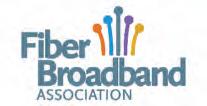
Mark Your Calendars for Fiber Connect 2022!
June 12 - 15, 2022
Nashville, TN Subscribe
Letter from the President & CEO
FBA Public Policy Committee Update
Tribal Broadband – Challenges and a Once-in-a-Lifetime Opportunity
Fight Club: Aerial vs. Underground Fiber
Making the Metaverse: Meta’s Randy Brogle will be among the keynote speakers at Fiber Connect 2022
Low Goals, Donut Holes and the Digital Divide: A Conversation with Kathryn de Wit, The Pew Charitable Trusts
Improving and Speeding Up Fiber Installments
Women Changing Fiber for Good – Insights From the Past, Improving the Present, Investing in the Future
The Future of Networks: 25G and Beyond
Ensuring Fiber Reaches Everyone – Views from the States
FBA Membership Update - Growth by the Numbers
Latin America: Fiber Growth and Challenges
FBA Rolls Regional to Baton Rouge & Providence
FBA Regional Connect & OpTIC Pilot Course Image Gallery
Broadband Education and the Digital Divide: A Chat with Ji Soo Song, U.S. Department of Education
LUS Grows Beyond Community Boundaries with NTIA Funding
Holland: Thirty Years of Steady Fiber Flowers to Full Coverage
Fiber Forward 2022 Editorial Calendar & FBA 2022 Event Calendar
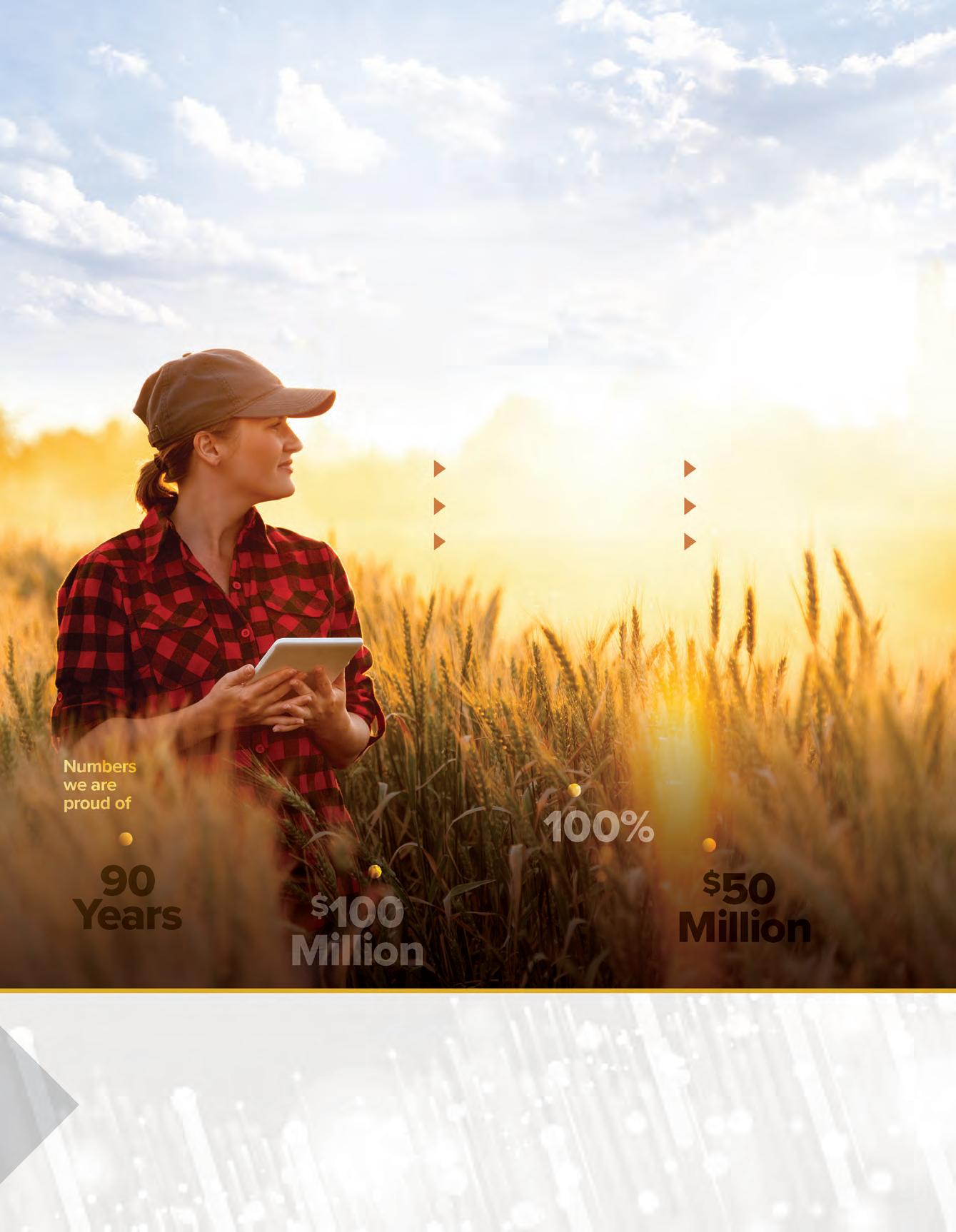
The first edition of the Broadband Infrastructure Playbook was released on March 4. A print version of the playbook has been sent to all 50 state broadband offices and territories, with an updated version incorporating the NTIA Notice of Funding Opportunity (NOFO) expected to be released in May.
Members should share and distribute the playbook to the largest extent possible when working with state legislators, broadband offices, and state policy makers. The Broadband Infrastructure Playbook is available for download on the FBA’s website at https://www.fiberbroadband.org/page/ playbook
One of FBA’s continuing roles is to keep federal legislators and regulators informed about the power of fiber, the importance of investing in long-term, future-proof broadband infrastructure, and the economic and social benefits it provides to the nation’s communities.
On April 15, FBA sent a letter to members of the House Energy and Commerce Committee and on April 26, FBA sent a letter to the FCC Commissioners underlining critical facts on fiber deployments in the United States and the importance of fiber as the fundamental communications infrastructure for the 21st Century. Deploying fiber creates jobs and economic development, supports and enhances public safety and other critical government services and paves the way for future services such as 5G and the Metaverse.
The challenge to the FCC’s award to CostQuest Associates to deliver the broadband serviceable location fabric (BSLF) has been dismissed by the Government Accounting Office and the project is finally moving forward. The FCC is also moving forward with the data collection process, which will be used to populate the maps, with operators required to submit the data on underserved populations to the FCC by June 30. The FCC has a stated goal to have the review completed by September 1.
The FCC’s new broadband mapping is expected to be available in the late fourth quarter of 2022 or early first quarter 2023. The first version of the mapping will be granular and
will not be completely accurate. It is not clear how NTIA will choose to implement the first version of the map, with the agency possibly waiting for the FCC to allow one round of challenges, but this could hold up the first round of BEAD grants. Alternatively, NTIA may allow filing of initial proposals based on the first version of the map and enable revisions based on better/improved map data later on.
FBA filed comments and reply comments to the FCC rulemaking for Broadband Consumer Labels have taken place, with an anticipated adoption date of November 15. The Label would require providers at point of sale to display the prices, including introductory rates, speeds, data allowances, network management practices, and additional terms and conditions for service.
FBA’s comments on the rulemaking emphasized that the Broadband Label should identify the service provider’s network technology (such as fiber) since the FCC collects this information and it is important to the consumer to understand and be aware of the underlying media as it has a direct impact on the quality of service and customer experience. Consumers prefer fiber over other media since they believe it is faster and more reliable than market alternatives, according to research conducted by RVA Market Research and Consulting for FBA.
FBA President and CEO Gary Bolton met with State broadband offices at the SLBN summit in March. Some offices noted that states are receiving conflicting information from cable and wireless providers when fiber is discussed. Others expressed concerns about permitting delays and mapping. FBA will share this insight with federal and state officials, and they work to help the industry move forward with fiber broadband as a mechanism to close the Digital Equity Gap.
The first two Regional Fiber Connect workshops took place at Baton Rouge, LA in March and Providence, RI in April. After a pre-conference workshop scheduled for Fiber Connect in June, two more regional workshops will take place, Copper Mountain Resort, CO on August 23 and Columbus, OH on November 3. More details on the first two regional events can be found on page 43 of this edition.
Delivering communications services on tribal lands is a complicated matter. According to the Federal Communications Commission’s 2021 Broadband Deployment Report, just under 79 percent of households on all tribal lands and under 65% on rural tribal lands in 2019 had access to maximum broadband speeds at the FCC’s current benchmark of 25 megabits per second download speed and 3 Mbps upload speed.
Part of the challenge is tribal broadband isn’t one entity but comprised of 575 individual nations distributed across the continent. Because of the vast spaces and low population densities on tribal lands, the economics of delivering broadband have been demanding. Adding to the complexity is that planning, building and managing broadband networks, with few exceptions, is outside the experience of most tribal broadband leaders.
The pending influx of federal funds and grant programs dedicated to broadband projects for tribal networks could start to make a difference, but there’s a lot of work to be done.

“There are ten tribes that have telephone companies - ten out of all the 575 recognized tribes in the United States,
only ten have telcos on their reservations,” said Godfrey Enjady, President of the National Tribal Telecommunications Association (NTTA) and founder and General Manager of MATI, the telecommunications company servicing the Mescalero Apache Tribe in New Mexico.
A number of tribes across the nation are served by small coops and local, independently owned telephone companies that are in good shape, but other tribes are in more dire straits because traditional network operators haven’t been able to find a model that makes closing this part of the digital divide feasible. “You have midsized and bigger incumbent carriers that are beckoned to their shareholders,” Enjady said. “They go where the money is. Investments are rarely made on reservations because if you have two to three customers per mile and a mile of cable costs you $60,000 to $70,000 per mile, your return on investment is not very good.”
While the federal government continues to increase broadband funding, tribes face the same challenges other smaller telcos have in the current supply chain environment. “Even if you get the money, where do you get fiber?” Enjady said. “Where do you get wireless towers? Where do you get all the stuff to build a broadband network if it’s in short supply?”

Utilities, Electric Co-ops and Telecom operators across the U.S. trust Enghouse with their broadband networks.
We have everything you need for a successful fiber expansion:
Fiber Planning
Hassle-free, accurate and GIS-based fiber planning and design for the most efficient broadband networks
Fiber Inventory
Smooth migration from any legacy network to fiber with advanced and automated reconfiguration and reconciliation
Fiber Performance Management
Solid network performance with automated service assurance
Fiber Billing
Reliable fiber billing and revenue assurance for a variety of wholesale and retail services
If you are looking for network reliability and performance, accelerate time to revenue, minimize planning and maintenance costs – contact us today!
The need for reliable broadband has never been greater for tribal nations. “The pandemic brought everyone home, so we needed Wi-Fi at home,” Enjady said. “We need to make sure there’s enough bandwidth so kids can go to school. With two or three kids at home, 25/3 isn’t enough bandwidth for simultaneous classes, so we’re looking at 100/20 as the new minimum standard.”
While there’s a lot of federal funding available today, tribal leadership needs to come up to speed on how to get and spend it.
“Some of the funding through NTIA, RUS and the BEAD money that’s coming in has tribal inclusion,” Enjady said. “Tribes can go get that, but many are not very aware on how to do broadband projects. Creating and operating an ISP is not super complicated, but it has its complications. We’re looking at how we can train and make tribal leadership aware of how a lot of this stuff works. Workforce development is another issue that has to happen if you put in a fiber network. Where do you get the guys to put in the fiber? If you hire contractors, are they going to take care of the fiber after its installed?”
Ongoing operations after the network is installed is an issue tribes need to fully understand. “Once you build that network, is there enough money coming in from customers to help pay for operations going forward?”
Enjady said. “If you’re running fiber for three to four customers per mile, there’s a high cost of operations and there’s not enough money there from those few customers to sustain the network. It’s like getting a new Cadillac but not getting any money for gas, oil or anything else. I’m trying to make tribes aware. I don’t want them to
get a black eye, especially when it comes to finding out that they get all the money for infrastructure but yet they need to be sustainable down the road.”
Some tribes have been successful with broadband network builds. The Mescalero Apache Tribe, located in South Central New Mexico, has deployed fiber to approximately 950 of 1,200 homes on the reservation, with plans to add the rest sometime next year. Customers with fiber can get gigabit speeds and full voice services.

Enjady said the Mescalero network was funded by securing a loan through the USDA RUS program for capital expenditures and then being able to pay the money back through revenue received from residential and business customers; the National Exchange Carrier Association settlements; and FCC Universal Service Fund (USF) subsidies, along with USF providing funds for ongoing operations.
“We don’t get grant money because that goes against what my formula is for sustaining our telephone company,” Enjady said. “We have to follow the rules and regulations of USF and not every tribe can do that because it’s a very complicated process. Unless the FCC eases up some of the restrictions on USF, it’s going to be a tough nut to crack for more tribes to create and operate phone companies like we do. We see most tribes starting by operating ISPs where they are providing basic broadband services without voice or 911 services. If they can achieve that and get good at it, they can graduate into becoming an ILEC or a CLEC with voice services.”
Enjady has held conferences through the NTTA to acclimatize tribes to the idea of building and operating
(cont. on page 56)
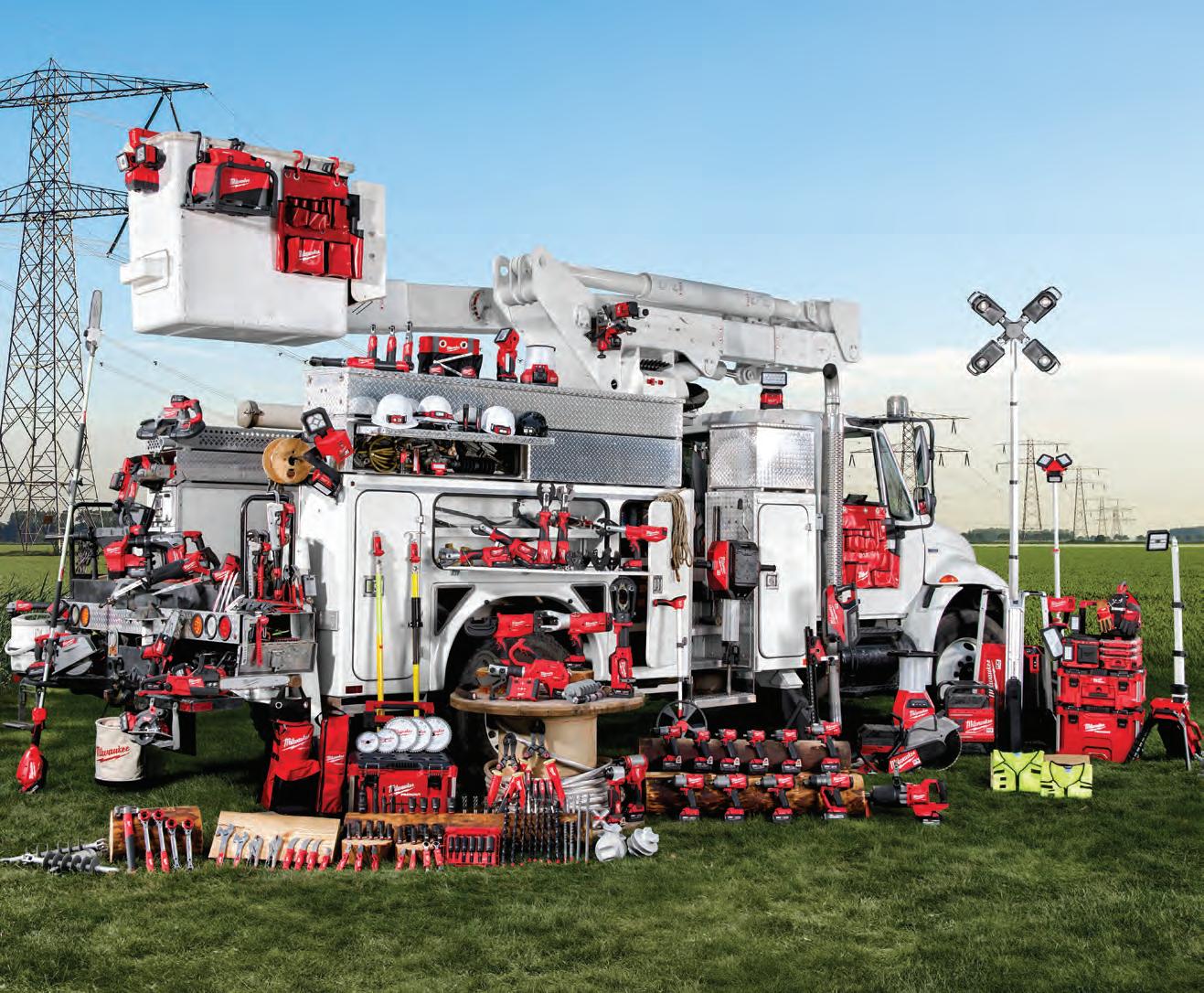
Network operators can have strong positions and intense feelings on how they do what they do. Fiber Forward talked to two operators about the decision to deploy fiber on poles verses putting it underground, an area where everyone has an opinion and there is no single correct answer.
Peoples Rural Telephone Cooperative (PRTC) in McKee, Kentucky made the decision to replace its copper plant with fiber in 2008. When it completed the task in 2014, it had replaced all its legacy copper and coax wiring in its incumbent service area using 1,000 miles of fiber, with about 70 percent of the deployment on poles and 30 percent buried. Since its initial build, PRTC has become a CLEC and added another 200 to 300 miles of fiber to its network, delivering service to adjacent territories with 95% of its expansion deployment aerial.
“I’m in the rural Appalachian Mountains and the terrain is a problem with buried fiber,” said Keith Gabbard, CEO, People’s Rural Telephone Cooperative. “With the rocky terrain and things like that, it’s less expensive to put in an aerial cable routing and there’s usually already an aerial electric cable route established. We have a really good relationship with our electric cooperative and one of the benefits of that is sharing poles. It helped our aerial plant deployment go smoothly.”
In its incumbent service area, PRTC owns many of its poles and pays for access to the electric co-op’s poles through a comfortable working relationship, where the utility provides timely make-ready schedules without exorbitant fees. As it expands outside of its territories,




PRTC finds pole usage a bit more complicated, with established cable, phone, and electric utilities already up and running.
“Being the fourth user, most of the time it’s not feasible to put another aerial attachment or the property owners won’t let you,” Gabbard said. “That’s difficult when you start getting into competition with all the other players.”


Burying cable is difficult depending on the presence of rock and the shape of the land. “We don’t have flat land where you can just put a plough on the ground and go for miles,” Gabbard said. “It’s up and down curvy. There’s very limited space along the road to put in cable. With aerial routes established by use or the electric co-op, it’s a lot cheaper for us to establish fiber on that route a second time than to bury it.”
PRTC’s underground cable plant has had its issues, especially when it runs through rights-of-way on private property. “A farmer was burying a cow and he cut the cable,” Gabbard said. “When you are in rural America, you may have rights-of-way approved and everything, but they just see it as their property, they can do whatever they want and don’t pay attention to us. People don’t want different kinds of utilities through their properties. Calling 811 is an inconvenience.”
Fixing cut underground cable on a private right-of-way can be awkward for PRTC. “We’re a cooperative. They own us,” said Gabbard. “When a cable is cut, we try to work with them so they don’t pay big fees. If we charge the full cost to fix a buried cable cut, you’re not going through their property again.”
In a few places, PRTC has had to move fiber off of poles due to the unheralded menace of wildlife. “A few times




The first rule of Fight Club is you do not talk about Fight Club.
we’ve had to go back and bury a few thousand feet just because squirrels chew it up and come back to the same place,” Gabbard said. “We just got tired of fixing it. It seems they come out at certain times of the year and they tend to come back to the same places time and time again.”
Uniti Group is a REIT that owns around 128,000 fiber route miles and 7.6 million fiber strand miles along with other communications real estate throughout the United States, providing leased fiber and lit services for transport carriers, enterprise and retail network, wholesale, and cellular backhaul. Depending on the customer, Uniti provides long haul, middle mile, and last mile services.
“We go underground as our first choice,” said Doug Parker, Uniti’s Director of Engineering. “We only go overhead when we absolutely must. Being in the Southeast, hurricanes are our biggest issue from a natural disaster perspective. Having fiber underground means you’re less prone to wind damage. But it does open us up when the recovery efforts come through to get hit by boring and construction when they’re putting things back together.”
For example, Uniti had fiber on poles in Panama City, but Hurricane Michael – a category 5 storm -- took the poles down. “Typically, that [storm level] doesn’t break our fiber,” Parker said. “It’s when the utilities came in and cut our fiber on the downed poles to put up new ones. That was the problem, so we went underground. As long as there’s nothing they have to replace, we’re a lot safer. But what happens is when the power or construction companies come in to rebuild, most of our damage came afterwards, not from the storm itself.” Being underground can also protect against wildfire damage, depending on how construction is configured.

Having fiber underground also protects from less predictable human and animal interruptions. “We’ve had
people shooting at aerial cable, pointing shotguns right at it,” Parker said. “People trying to steal copper is a big issue these days. They can’t tell the difference between copper and fiber, so they just take bolt cutters and start cutting and you’ve got a 288 [strand cable] or a 488 [strand cable] cut in half.”
The only time when Uniti will use an aerial route is if there’s no underground right-of-way available or if there is a timing issue where they need the fiber route turned up more quickly.
While putting fiber underground is more costly, it also provides more options once the initial build is completed. ‘Your expandability is greater with a conduit verses an attachment on the pole,” Parker said. “Typically, if you put in a two-inch conduit with fiber [cable], you can pull multiple cables through there, whereas with poles, you are lashing to the existing route. From a maintenance and upgrade perspective it’s easier to maintain underground.”
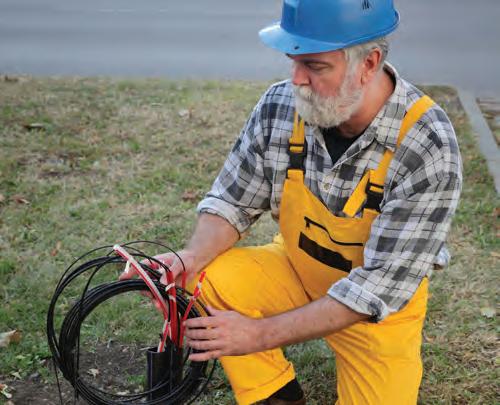
The biggest headache with underground deployments is rock. “Drilling through it is expensive to bore through,” Parker said. “A lot of time’s you’ll look for alternative ways around it just to get your fiber around it rather than drilling straight through. We had this problem in Birmingham, Alabama and we had to do some microtrenching along the roads to be able to get fiber in place because the rock is so dense and you just don’t have the time to cut through it.
Choosing a particular fiber deployment methodology is as much dictated by geography, geology, and weather as anything else. Aerial fiber can be deployed more rapidly and more affordably when available but is subject to the elements of nature and the nature of animals large and small. Underground deployments cost more and are not economically viable in rocky terrain but provide better physical protection against natural threats such as forest fires, weather, and wildlife.
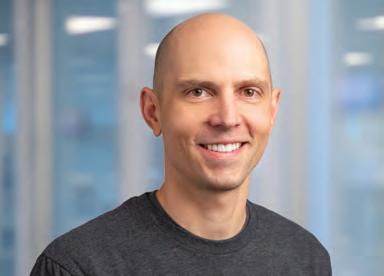
Service providers are facing a ‘perfect storm’ of challenges as they look ahead to 2022, according to Alianza’s CEO, Brian Beutler. The pressures of aging infrastructure, eroding margins, and an aging workforce are all obstacles that need to be addressed by service providers if they are to remain relevant.
The biggest of the three challenges for service providers is moving away from legacy systems that are reaching end of life. These platforms are, in some cases, 40 years old and only going to become harder to support and maintain.
Another challenge for service providers is slipping revenue and subscriber bases, with users ditching landlines in favour of mobile phones. This drop in revenue comes as service providers face the same cost structure, resulting in the eroding of margins — with the gap only widening.
Many employees qualified to maintain older, legacy voice technologies are now retiring. Finding replacement staff with the same skill set is difficult and organizations find it difficult to justify that training younger employees dated technology.

“These three factors create a perfect storm effect. By moving to the cloud, service providers can have healthy and predictable margins, reduce reliance on legacy technology, and apply their skilled labour to more strategic initiatives. In addition, they future-proof their network and avoid kicking the can down the road by replacing hardware with hardware, only to face the same challenges and exorbitant capital expenditure for replacement in another five to seven years.”
Many service providers are caught in limbo: knowing all the above to be true but unsure how to take their first steps to the cloud while keeping the lights on. This is often driven by fears of service disruption, which could upset customers. Alianza specialises in helping service providers take that first step by easing their migration to the cloud with an experienced, dedicated customer success management team. To learn more about how Alianza can help, visit our website today!
Beutler Chief Executive Officer - AlianzaThe company Meta, formerly known as Facebook, wants to enable an accessible vision of the Metaverse for everyone, but it’s not entering this journey alone. It will require collaboration and effort by all parties building and enabling today’s networks to deliver on tomorrow’s endless possibilities.
“In order for the Metaverse to become a reality it’s going to take a lot of partnerships and collaboration across the entire ecosystem, including what we call the connectivity industry,” said Randy Brogle, Meta’s manager of network investments. “There’s a huge opportunity across that whole spectrum of many, many partners and collaborators that starts with devices in people’s houses, to the bandwidth connections into those houses that take them into the cloud, which hits all the service providers in that value chain, all the equipment vendors, all the construction firms, all the developers that are building applications for these devices at one end or the other. There’s an enormous ecosystem to bring to the table.”
Meta has been a catalyst for establishing industry standards, creating the Open Compute Project more than a decade ago to promote the benefits of open source and open collaboration for data center hardware and then expanding those efforts into telecom hardware. It is prepared to play a similar role for the Metaverse.

“We’ve come up with this term of a Metaverse-ready network,” Brogle said. “What does that mean and how
do you best support that? There are a couple of keys. We think there’s going to be a much bigger need for openness and interoperability; it’s a large partnership across the whole industry. More specifically to fiber networks, it’s going to require significant improvements in what people get today in their houses for the most part, including the end-user bandwidth, the overall speed of the network, having a symmetrical network and much better latency than happens today in many applications.”
“The last part comes back to this: The Metaverse is not one single company or industry, it’s not just one fiber provider and it’s not just one content company like Meta. It’s going to have to be this convergence and collaboration on a global effort to reach it.”
Brogle noted that exact standards and benchmarks for a Metaverse-ready network are yet to be determined and shouldn’t be set into stone today. “The answer to many things in life are ‘it depends,’” he said. “It will depend on the specific application and the specific devices involved. This is where industry collaboration comes in. Is there a fixed firm number that needs to happen today? Probably not. I’m not intending to say, ‘This is the number, everyone needs X and Y’ and go there, because it’s changing, evolving and it’s a moving target. We have a lot of conversations internally about what the final network requirements will be.”


IMMCO has designed networks since 1992, across all major technologies (5G, Fiber, HFC, and Copper) and platforms with international clientele.

Now IMMCO Inc. is a part of GTS! In operation since 1993, GTS has completed network construction projects across the US and has 4 major divisions: broadband, wireless, outside plant and building technologies. Use

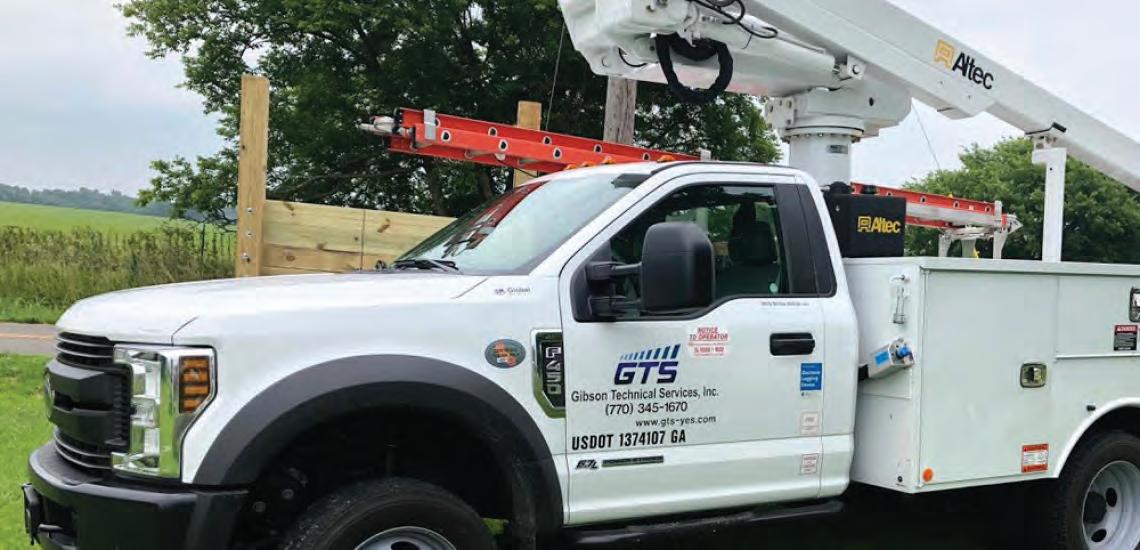
Latency is one area Brogle cited when “it depends” on the application type. A successful video call requires around 150 milliseconds of latency, while conducting an immersive VR experience requires latencies of 30 milliseconds or less.
“If I were to make a statement, I’d say lower latency is always better,” Brogle said. “As low as we could go across the broad set of the population of the world, but I think we’re now throwing out numbers to say what tomorrow’s cloud should be. It shouldn’t be a line in the sand.”

During the pandemic, Brogle and his family, like most others around the world, confronted the reality of preset limits not being adequate for the changing needs of today’s applications. “Being in a household with two working adults and two teenagers doing online schooling with three to four video calls at a time, 3 Mbps of upload does not cut it,” he said. “Symmetrical is good, getting to 100 Mbps is absolutely good and getting to a gig would be better. We want investment in network technology that allows progression to higher speeds and performance without a major overhaul or a major changeout of what’s built to the consumer’s home or in their home.”
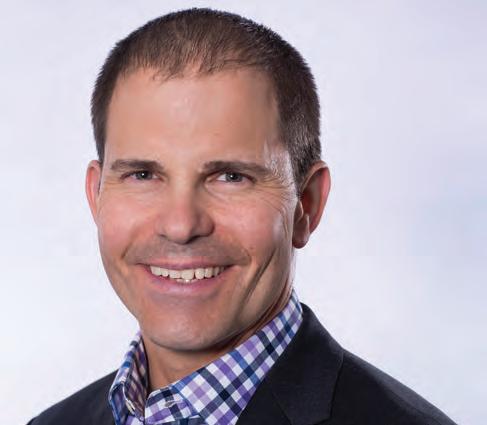

Enabling Metaverse-style applications will be more than just broadband, with an ecosystem that includes more computing and storage resources closer to the consumer to lower latency. “Pushing content to the edge to improve delivery, peering, and interconnects has been happening for years and will continue to evolve over time, not just for Meta but for the whole industry,” Brogle said. “The more peering points that come up and the more that are available make it an ecosystem dynamic for better network performance.”
Brogle doesn’t expect a Metaverse-ready world to arrive tomorrow but will emerge from a larger continuous evolution of the Internet into a new form as a collaborative effort by all companies involved. “The Metaverse is the name for this next journey and it will not be something that happens overnight,” he said.
Google Fiber believes that everyone deserves fast, reliable, fairly priced internet.




We do that by bringing together diverse ideas from a variety of smart, talented people in an atmosphere that lets them make tangible impact, own their careers, and be empowered to think bigger.
So when you’re ready to enhance your skills while putting your ideas into action, build your career creating fast, reliable internet for everyone.
Apply now at fiber.google.com/careers
The internet is better when everyone adds to it. Our team is, too.Randy Brogle, Meta’s Manager Fiber Infrastructure Solutions, shares a vision for the Metaverse. Source: Google Fiber. Fiber Connect 2022 Keynote Speaker
As project director for the Broadband Access Initiative at The Pew Charitable Trusts, Kathryn de Wit oversees the non-profit’s efforts to close the digital divide. On any given day, Kathryn’s efforts include collaborating with policymakers, researchers, and other stakeholders, all working to improve policy outcomes, address research gaps and bring together contributors for data-driven discussions about how to ensure every American benefits from universal connectivity.
Through the Broadband Access Initiative, Pew is working to accelerate progress to increase the availability of high-speed, reliable, and affordable internet through a combination of research, policy change, accountability, direct support to states and state lawmakers, and stakeholder engagement.
De Wit will be presenting her latest work at Fiber Connect 2022 on June 14, as part of a general session keynote. Fiber Forward sat down with her to discuss the landscape of opportunities and challenges communities

and states face as each build out networks to serve all citizens.
How much of an impact on the digital divide do you expect with the Infrastructure Investment and Jobs Act (IIJA) and all the other state and federal monies flowing in?
What we know is the investments specifically through the IIJA, the Emergency Connectivity Fund, ARPA, as well as the funds that states have already put forward, will make a significant impact on closing the digital divide.
Will it completely close? No, it probably won’t ever close because technology evolves and changes. But we want to make sure we don’t create another digital divide five or ten years from now. That’s why Pew recommends that states and the federal government prioritize investment in fiber as they start the process of upgrading the infrastructure and the networks across the country. By doing this, we aren’t running into the issues we see right now with network performance and the outdated 25/3 broadband definition.
It’s important to remember yes, the nation is making a significant investment in broadband. But this is also a very expensive problem to solve, not only to connect some of these unconnected households, but also to maintain the network in the long run. We can’t think of this as a one-time expense since networks have operational and recurring maintenance costs.
Broadband is infrastructure. It is going to make a significant difference in increasing the number of Americans who have access to and can use an affordable broadband connection. But we do still need to be thinking about longterm cost and maintenance operations as well. This is part of Pew’s ongoing work and focus.
At every level of government, it’s setting broadband goals too low. When a state defines broadband as 10 Mbps down and 1 Mbps up as Florida did in 2021, that’s a problem. At the other end of the spectrum, states like Washington will not spend money on any infrastructure incapable of delivering speed of 100 Mbps down and 20 Mbps up.
Policy needs to move beyond a very narrow understanding of available and “good enough.” Is that connection available? Is it “good enough” just to do basic online activities? If COVID-19 showed us anything, it’s that “available” and “good enough” usually aren’t sufficient. Instead, policy should be set to ensure public dollars are invested in infrastructure that enables people to access the goods and services and opportunities of the 21st century economy.
After goals comes accountability.
Lack of accountability for whom? The service provider or the state or…?
Across the board. It’s important that accountability is not only applied to those who are receiving public dollars, but it is also applied to those who are administering the public funds.
For those who are receiving these dollars, the grants, or loans themselves, we have to start asking better questions, about their ability to meet community need, be good stewards of public funds, and meet the funding requirements.
Turning to those overseeing these programs, they have a responsibility to the public. Are they performing their oversight function well? Ensuring that recipients meet their deadlines or working through challenges to ensure communities get connections or support that was promised? Are they making progress towards the goals that they, as the state or the locality or the federal agency, have established?
That accountability has been lower than we would like in most cases, particularly at the federal level and in some states, but not all states.
What else does the federal government need to work on?
Federal agencies need to improve their coordination. Funds are being administered through a growing list of agencies, some with decades of experience in broadband and some with zero.
I’m pleased to say that these new federal entrants are serving as drivers of change. For example, the Department of Treasury has set higher requirements for broadband spending than the Federal Communications Commission (FCC) has. There is also additional attention being paid to accountability, oversight, and equity. Those factors help us step away from an outdated assessment of “cost efficiency” and focus on the return on investment and community impact. From requiring providers accepting public funds to provide an affordable offer to setting preferences for fiber and faster build timelines, federal agencies are beginning to act on the concept of the fully connected community.
But if there is not sufficient coordination, alignment between federal agencies, we run the risk of misusing funds and running into criticisms of overbuilding networks.
(cont. on page 55)
Policy needs to move beyond a very narrow understanding of available and “good enough.” Is that connection available?
Is it “good enough” just to do basic online activities? If COVID-19 showed us anything, it’s that “available” and “good enough” usually aren’t sufficient. Instead, policy should be set to ensure public dollars are invested in infrastructure that enables people to access the goods and services and opportunities of the 21st century economy.
Decreasing time to install fiber can lead to more homes passed and more people connected. Source: Adobe Stock
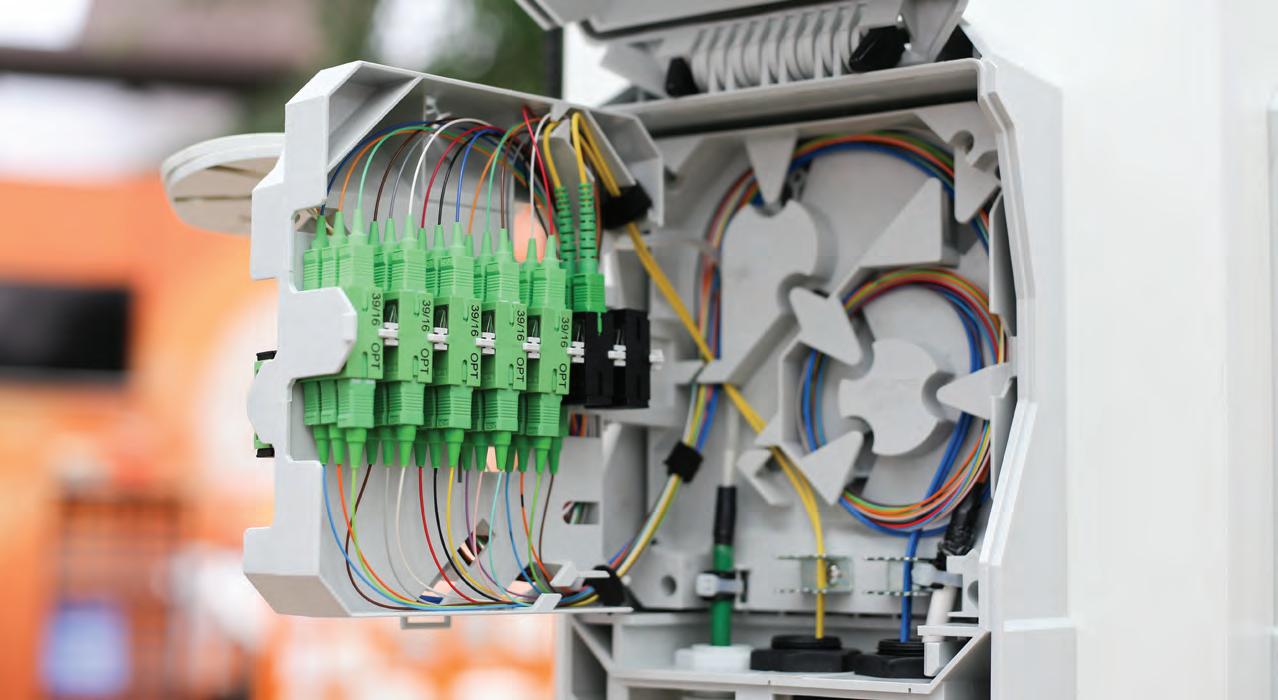
Connecting new households to a fiber network represents one of the more challenging tasks for network operators today. Now more than ever, service providers want to turn up new customers as quickly and efficiently as possible but face significant challenges as demand for skilled labor continues to grow while supply chain difficulties further slow the process.
“The lack of raw materials has been tough, especially for cable and hardware equipment,” said Johnny Hill, Chief Operating Officer of Clearfield. “But it’s the availability of labor out there for the amount of work that’s being done, and the skill set of available labor continues to be an increasing problem. There just simply isn’t enough of it to support all the work that’s going on and planned for in the near future.”
In his role as COO, Hill spends a lot of time on the road talking and listening to service providers as they build fiber networks to meet the demands of modern society. Hill believes the situation with the existing fiber installation labor force is only going to become more challenging and likely more expensive.
“There’s a lot of workforce pillaging of different contractors,” said Hill. “I think that’s going to raise what it costs to install fiber. The other thing that we see is the old guard of installers and trainers moving out and there aren’t enough training organizations or programs to deal with demands for incoming new installers right now.”
Larger organizations that once had dedicated training programs for fiber technicians are becoming less willing to keep up those resources at previous levels. “We work a lot with an incumbent phone provider that had a fantastic training organization plus an in-house organization whose job was to write the installation and testing procedures for the approved products in the network and then train and audit the workforce,” said Hill. “We see less and less of that dedicated process and effort today. Service providers are pushing out to the manufacturers to provide that training now and we do a lot of that with our products, but I know it’s happening with everybody else.”
Even when Clearfield provides training on its products, service providers are under pressure to maximize their workforce. “If they come to us, that pulls people out of the
field for two or three days,” Hill said. “When people want to use our training programs, they want it to be on site and more abridged because they don’t want to pull those people out of the field for several days at a time.”
Hill noted that unlike other trades, such as plumbing, electrical, and carpentry, there are no widely available apprenticeship programs for telecom, but there are a few starting to emerge in unique places. “The Department of Defense (DoD) is offering a new program to place people recently out of the military into a type of six-month fiber technician apprenticeship with service providers and they’ll pay for it,” said Hill. “The DoD, like everyone else, is looking for good bodies they can train.”
The contracted cost for a fiber technician varies based on geographic location. “It’s certainly a lot more expective in Alaska than in Mississippi because of the shorter season to do work,” said Hill. “We see a range between $15 to $20 an hour for a typical install and a final drop from a fiber terminal to the house is one and a half to two hours.”
Hill’s time and cost assumptions for fiber installation are based on having the home within 150 feet or less from a pole or pad to where the terminal is in the household, with longer distances costing significantly more. “The majority of the time a tech spends installing services is on provisioning the home, wiring infrastructure or finding the best place for the location for the wireless device for inhome services if that’s what they’re placing,” he said.
One of the most common fiber installation errors Hill and his staff of application engineers regularly see is remarkably simple and becoming much more important to fix as network operators move to gigabit and multi-gigabit speed services.
“With the increase in bandwidth speeds, the need for a clean, reliable connection is critical. The proper cleaning of a connector end face and having the skillset to troubleshoot a dirty end face of a fiber is consistently a top root cause for troubleshooting when turning up last mile services,” said Hill. “This is a major shift for the industry. In the past, technicians didn’t really have to clean or inspect connectors like they do today. The data from numerous studies we’ve seen show that 97 percent of network outages are from dirty or damaged connector end faces because they were dirty when they were made.”
Clearfield is spending an “enormous amount of time” providing online and in-person training through its Clearfield College programs on the proper way of cleaning hands and fiber ends. Proper cleaning can also yield performance benefits. “We’ve got customers out there that can daisy chain terminals much farther than we recommend,” said Hill. “But that’s because they’re very diligent about training the technicians and know what they’re doing on cleaning an end face. Therefore, they’re leveraging their fiber assets much better. It’s difficult to get across the benefits of cleaning, but it’s paramount.”
Improving fiber technician training and having enough technicians on hand is a good foundation for turning households up, but there’s a couple of other things that can be done to accelerate the process. “You want to have a plug and play approach that minimizes the need for splicing in your access network,” Hill said. “Do not deploy splicers to splice on a connector for every connector. Use terminals and drop cables that are completely plug and play. Keep the splicers to the larger fiber trunks and consolidation points. This allows you fewer SKUs and offthe-shelf products.”
Clearfield and Hill see providers running into problems trying to train and inventory multiple product configuration SKUs to deal with every situation they may encounter on a network or at an access point to optimize link budget and cost. Instead, reducing SKUs to a minimum of one or two reduces the training that has to be performed and leads to fewer mistakes as well as shrinks overall inventory for hot spares, leading to a lower total cost of ownership.
However, introducing plug-and-play practices into fiber deployment to further simplify the need for skilled labor can add different complications between the service provider and contractors. “The [billing] model contractors use relies heavily on splicing,” said Hill. “A higher skilled operation requires a higher skilled, and more expensive, technician. When plug-and-play is introduced to the contractor, they’re kind of reluctant to embrace it. The service providers are striving to achieve a balance between capital expenditure and speed of deployment for peak operational efficiencies, so plug-and-play is their answer.”
“Providers need to negotiate compensation with their contractors up front when using plug-and-play tech. The manufacturer – us – becomes the mediator between both
(cont. on page 57)
With the increase in bandwidth speeds, the need for a clean, reliable connection is critical.
– Johnny Hill, Chief Operating Officer of Clearfield.


When we envisioned how to showcase the impact that women are having on the fiber broadband industry, the editorial team at Fiber Forward debated, discussed, and decided to focus on how nominees are changing the fiber industry for good, in two senses of the word - longevity and positively.
First, we focused on women that are making changes that will be felt for years to come and second, uncovered how they are making the industry better. We relied on the leadership of the FBA’s Women in Fiber Committee to review each submission and give us their insight in which women could best help Editor-in-Chief Doug Mohney tell this story.
To be clear, this process was not a formal contest or an award. We were overwhelmed with recommendations – 42 in all, representing every aspect of our industry, every discipline within our companies and every level of contributor.
From this list of recommendations, 12 women were asked to share their perspective. Their insights fill the pages of this issue of Fiber Forward, but we would be remiss if we didn’t acknowledge all the nominees, for whom we simply were unable to include due to the time and space constraints of a magazine format.
Your colleagues, companies, and industry applaud your effort to change fiber for good. Congratulations to the following nominees!
• Julie Babiracki, National Channel Director, Consolidated Communications
• Christy Batts, Chief Broadband Officer, CDE Lightband
• Taylre Beaty, Broadband Program Director, Tennessee Department of Economic and Community Development
• Suzanne Blackard, Marketing Manager (Fiber), Shentel
• Kathryn Bonds, Creative Director, Cumberland Connect
• Alysha Bowers, Director of Business Development and Customer Engagement, empower, Delivered by Craighead Electric
• Audrey Bright, Director, Enterprise Sales, Shentel
• Ashley Brown, Senior Director Field Marketing Americas, Adtran
• Carla Cooper, Chief Financial Officer, Bluebird Network
• Teresa Ferguson, Senior Director, Broadband and Infrastructure Funding, NRTC
• Martha Galley, Executive Vice President, Customer Engagement and Services, Calix
• Joanne Galloway, Executive Director, Center for Change, a Northern Michigan Advocacy Group
• Elizabeth Killion, President/CEO, Killion Communications Consultants, Inc.

• Sarah Lang, CEO, Local Linx
• Lisa Leary, Vice President, Commercial Sales, Consolidated Communications
• Lauren Marcucci, Project Manager, Brungardt Honomichl & Company
Sincerely,
• Kara Mullaley, Market Development Manager, Corning Optical Communications
• Mollie Nycum-Duvnjak, General Counsel and Head of People, Biarri Networks
• Lisa O’Day, Network Engineer, Consolidated Communications
• Jennifer Prather, Chief Executive Officer, Totelcom Communications
• Karen Rohrkemper, Senior Vice President Project Delivery, Design & Construction, Crown Castle
• Constance Satz, Manager, Engineering, Consolidated Communications
• Heather Scattergood, Project Manager, Network Building + Consulting LLC
• Laura Smith, VP Design Services, Biarri Networks, Pty Ltd
• Misty Stine, Executive Vice President of Business Development, eX2 Technology
• Kayla Wade, Senior Manager of Fiber Marketing and Subscriber Support at OEC Fiber, OEC Fiber
• Traci Wietrick, Director of Broadband, Cooperative Electric Energy Utility Supply, Inc.
• Lisa Wigington, Vice President of Strategic Operations, TEC
• Jennifer Yohe, Chief Operating Officer, DZS
• Joy Yount, Area Manager, Fiber Optic Services, S&N Communications
The fiber broadband industry is at the cusp of a transformational shift. The work it will complete over the next decade will change the fabric of our lives in ways we expect and with possibilities we cannot yet imagine. These changes are external in terms of the communities we serve, but also internal in terms of how we grow as individual companies. The FBA’s Women in Fiber committee is proof of this shift, and we wanted to learn more about how the women that are helping lead the industry forward are making changes within their own companies and the broader industry.
We asked 12 leaders, nominated by their companies and selected by the Women in Fiber leadership team, to share their thoughts and insights on various topics including: how the industry has changed since they first started working in telecommunications; how diversity helps the fiber industry to grow, thrive, and create possibilities; how they are changing the industry for the better and the long term; and the advice they would give their younger selves if they could share what they know now.
Participants in the discussion included:
• Cheri Beranek, President & Chief Executive Officer, Clearfield
• Veronica Bloodworth, Executive Vice President & Chief Network Officer, Frontier Communications
• Abby Carere, Senior Vice President, Marketing, Sales & Account Management, Conexon
• Cheryl Choy, Senior Vice President, Broadband Product Development, AT&T
• Marina Alderete Gavito, Executive Director, SA Digital Connects
• Tamika Green, Senior Director – Network Planning, Engineering and Construction, altafiber
• Crystal Ivey, Fiber Broadband Team, Knoxville Utility Board
• Betsey Kirk McCall, President & Chief Executive Officer, 7 States Power Corporation
• Carmen O’Neill, PE, Director of Engineering, Vantage Point Solutions
• Shazia Sobani, Vice President Network Implementation, TELUS
• Jill Szuchmacher, Chief Strategy Officer & EVP Networks, Ting Internet
• Julie Wagoner, Vice President, Customer Service & Technical Support, Shentel
This article captures the highlights from our conversations as the insights shared would have filled all of the pages of this magazine and then some.
Adams Cable Equipment is a strategic distributor of fiber optic cables and materials for modern telecommunications and fiber optic networks. Relationships with manufacturers and providing the highest quality cables around means ACE can be a valuable asset for your next project. Our familiarity in the industry and years of expertise will give your company peace of mind when sourcing materials.
We have stock and access to full and partial reels of loose tube (armored an non-armored), flat drop (tonable and non-tonable), Ribbon, Micro, ADSS, Indoor Plenum/Riser, and multimode fiber optic cable from several manufacturers.

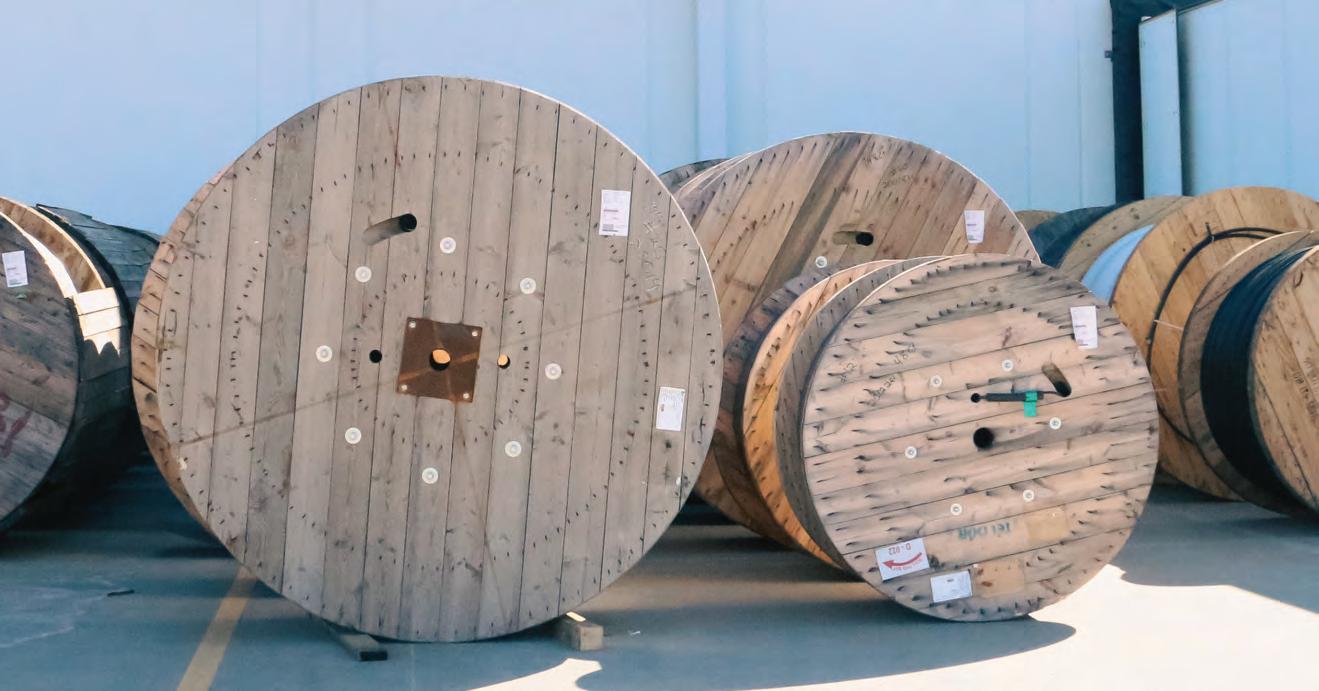
The women we spoke to have seen enormous transformation across decades of service in the industry through evolving technology, investment, and culture.
Technology is the most obvious area of change over the years noted by our participants. “The dial-up modem was a big deal!” said Cheri Beranek, President and CEO, Clearfield. Others mentioned pagers, “You’ve got Mail,” Palm Pilots, Blackberries, DSL, and TV antennas, noting how different today’s society is with fiber connectivity and smartphones.
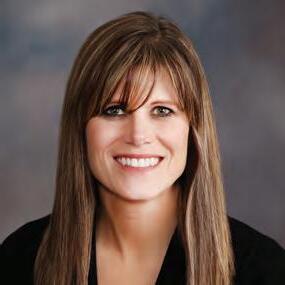
Attitudes for the necessity of broadband have moved significantly. “Internet access has shifted from a form of entertainment to a basic need that enables remote learning, access to telehealth and expanded employment opportunities,” said Tamika Green, Senior Director –Network Planning, Engineering and Construction, altafiber.
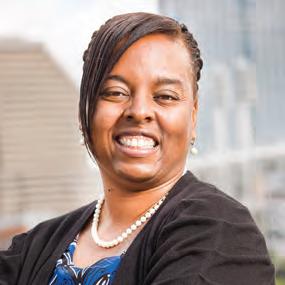

Less obvious but more impactful are developments in broadband investment strategies. Publicly traded companies conducted initial fiber builds in urban areas before starting to move to mid-sized markets, while federal funding has gradually brought broadband to unserved and rural communities. To fill in coverage gaps, municipalities and cooperatives have championed the construction of local networks in the absence of other competitive alternatives.
But by far the most notable social change were women becoming more visible and present as leaders in the industry. “I spoke at ACE (Association for Communication Engineers) in 2003 or 2004 and was introduced – I remember this so clearly – as the first woman speaker they’d ever had,” said Carmen O’Neill, PE, Director of Engineering, Vantage Point Solutions. “It just seemed crazy to be the first. Now a lot of women have spoken there. We’ve reached a point where it’s less notable and that’s good.”
“When I first entered the telecommunications industry, there were not a lot of women leaders or people of color in leadership,” said Cheryl Choy, Senior Vice President, AT&T Broadband Product Development, AT&T. “I am so fortunate today to be surrounded by an ever-growing group of diverse and intelligent women that help make our products and services better for our customers.”
Women are establishing a strong presence within telecommunications firms. Choy said she has at least 50% representation of female direct reports in her division at AT&T while Shazia Sobani, Vice President Network Implementation, TELUS, has a team working on TELUS’ copper decommissions project that is more than 40% female.
Examples of women playing a greater role at individual companies, at all levels, was a common theme in the discussion, as everyone has noticed a shift for the good. Diverse teams and workforces were viewed as a strength, providing new ways to look at problems and find solutions across a wide range of issues and better meet the needs of all customers.
“Putting the customer at the center really requires us to make sure that we reflect the diversity of the communities we work in,” said Jill Szuchmacher, Chief Strategy Officer and Executive Vice President Networks, Ting Internet. “If we as an industry don’t mirror the diversity of our customers, how could we possibly serve them well?”
“People don’t all seek the same experience or have the same needs,” said Veronica Bloodworth, Executive Vice President & Chief Network Officer, Frontier Communications. “The user experience must be considered from as many perspectives as possible. Diversity allows us to ensure the industry evolves to keep up with global demand, not just the needs of a small subset of the population.”
Internet access has shifted from a form of entertainment to a basic need that enables remote learning, access to telehealth and expanded employment opportunities.
– Tamika Green, Senior Director Network Planning, Engineering and Construction, altafiberTAMIKA GREEN CARMEN O’NEILL
“Diversity is about inviting different perspectives and thoughts to enable the true outcome of collective genius,” said Sobani, TELUS. “Diverse perspectives allow us to evaluate ideas and risks differently. Diversity and bringing diverse ways of thinking together is a strength that leads to better outcomes across all lines of business. There is a plethora of studies to demonstrate both the business value and cultural value in prioritizing diversity in our workplaces, and the fiber industry is no exception.”
“If we surround ourselves with people like ourselves, we will always experience the same results. Boring!” said Julie Wagoner, Vice President, Customer Service & Technical Support, Shentel. “Diversity amongst our team and across our organization challenges us to think differently, to see things from other viewpoints, to try things differently... It is also important to see this diversity in leadership. When women see other women in positions of leadership and decision making, it gives them a sense of connection, inspiration, and empowerment.”

The participants we spoke with lead organizations, building the products, services, and networks that deliver high speed broadband to homes, businesses, and communities across America, including new institutions within and across state lines.
“I serve on the team leading a municipally-owned utility and new entrant in broadband,” said Crystal Ivey, Fiber Broadband Team, Knoxville Utility Board (KUB). “When complete, KUB will own and operate the largest municipal fiber network in the US with service to over 230,000 households and in parts of seven counties. We will provide FTTH to every single household and business in our electric footprint. Universal fiber will transform Knoxville and the surrounding area and ensure that our community has the technology assets necessary to grow and thrive.”
“We have been building the 7 States middle mile project from scratch over the last few years,” said Betsey Kirk McCall, President & Chief Executive Officer, 7 States Power Corporation. “Women are being placed in leadership roles and are excelling in the telecommunications space across the Tennessee Valley. We are blessed to have women serve on the team who are trailblazers in the telecom industry such as Katie Espeseth at EPB of Chattanooga and Teresa Newman from Bowling Green Municipal Utilities. We anticipate this trend will continue as the project progresses and we connect the 153 local power companies across the seven states.”
Our participants also emphasized developing leadership and workforce qualities such as teamwork, passion, collaboration, and mentorship.
“Building strong teams of talented, forward-thinking individuals who work together to innovate and re-invent the possible is the key to changing the industry for the good,” said Bloodworth, Frontier Communications.

“Changing the industry for the better requires leading by example and frequent engagement with our team,” said Wagoner, Shentel. “Transparency helps leaders and team members know that you trust them with information and that you rely on them to continuously improve. Being intentional around showing recognition with the team is important to help them understand their value and how they contribute to the big picture and how they are making a difference to their customers on each interaction. When they realize this, their work means

If we as an industry don’t mirror the diversity of our customers, how could we possibly serve them well?
– Jill Szuchmacher, Chief Strategy Officer and Executive Vice President Networks, Ting InternetSHAZIA ZEB SOBANI CHERYL CHOY
something and they pour everything they have into what they do.”
“With my background in tech and innovation, I’m open to different innovative ways to tackle long-standing problems,” Marina Alderete Gavito, Executive Director, SA Digital Connects told us. “These may not be ‘convenient’ ways of getting things done, and I face a lot of ‘that can never happen’ type push-back. To me, it’s crucial to get people connected to the internet so they can apply for jobs, see when the food bank line is open, access our city’s services...that I can no longer settle for the convenient way of getting things done and we need to push the envelope on trying new ways to solve these long-standing issues. These are our neighbors and so I won’t stop until this problem is rectified.”
“I am a big believer in the power of sponsorship and mentorship for personal and career growth, and in my own career I have been very fortunate to learn from incredible leaders who invested in me,” Szuchmacher, Ting Internet, told us. “I see my most important job as helping to develop leaders, especially those who are often overlooked inside organizations - whether that’s because of their community of origin, their gender, or because they are simply quieter than the stereotypical extroverted leader. Amplifying voices with new ideas and perspectives strengthens our industry, drives innovation, and improves our ability to serve communities.”
Participants for this feature discussed building fiber networks across the country to be used for decades, enhancing economic vitality by creating jobs and providing flexibility for people and families on where to live and work. They also talked about improving their own organizations and creating the next generation of female leaders.
“I hope to build a community-driven organization, leading
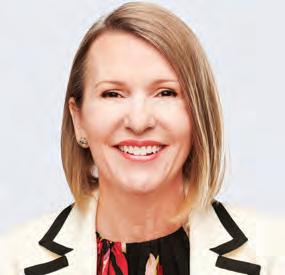

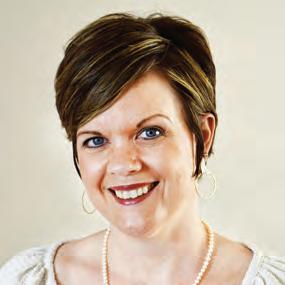
by example, to demonstrate that family comes first, and we are working to make healthy, happy families something that is in the grasp of everyone,” said Beranek, Clearfield.
“As a leader in the organization, my objective is to empower and support my team in achieving our corporate goals while developing them to become future leaders in the organization and in the industry,” stated Green, altafiber. “In my community, I am a youth advisor for an organization focused on assisting teenage girls to develop into adulthood, serve their community and pursue their post-secondary goals. I also serve as a mentor for those young ladies interested in pursuing careers in technology or telecommunications to ensure there is a future pool of diverse talent ready to enter and contribute to the industry.”
“We approach every project with a long-term perspective, because if you put this network in the ground, it better work for decades,” said O’Neill, Vantage Point Solutions. We’re taking that future and pulling it into the present… I look at younger engineers, they’re just starting their careers. I want them to grow, I want them to develop, I want them to rise up so they can take my place. They are the next generation, and part of my role is making sure they’re ready to take the industry where it needs to go.”
“I view the impact I can have on changing the industry for the better and for the long term as one in the same,” said Wagoner. “My focus is on building a strong team of leaders and individual contributors who share a common goal –offering a best-in-class experience with every opportunity we get and providing a superior product to our customers. Most importantly, be kind – we MUST be kind… When we build the right team and have the right players on the field most things fall into place. When we do face challenges and hit bumps in the road, the investments we’ve made in developing our team and building relationships with others pay full dividends to help us problem-solve and move forward.”
VERONICA BLOODWORTH JULIE WAGONER CRYSTAL IVEYI look at younger engineers, they’re just starting their careers. I want them to grow, I want them to develop, I want them to rise up so they can take my place.
– Carmen O’Neill, PE, Director of Engineering, Vantage Point Solutions
• Native XGS-PON (OMCI) integration
• Lowest CAPEX, Highest ROI
• No construction, no mess
• Installs and activates in hours
• Fully featured carrier grade solution

Eliminates concerns about the FCC ruling which allows competitors to use your in-building fiber wiring investment
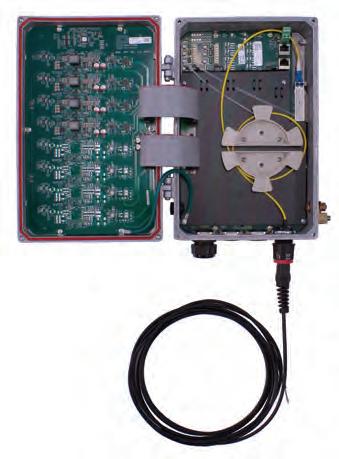

Widely Deployed by Carriers and ISPs

The answers to this question were the most challenging part of the interviews for Fiber Forward because there were so many thorough, insightful answers that reflected the unique journeys each of our participants have had to get to where they are today as leaders in the telecommunications industry.
“Pursue something you are passionate about,” said Abby Carere, Senior Vice President, Marketing, Sales & Account Management, Conexon. “One of the hardest things for young professionals is finding out exactly what and where that passion is. I’m lucky to be in an industry where we truly change people’s lives. You should never choose a job or career solely on income -- find something you are passionate about and success will follow. You may not find that in the beginning of a career, but don’t give up.”
“There’s always going to be obstacles to face but pushing through those is the only way to truly succeed,” said Choy, AT&T. “As a leader now, I’d add that it is important to be encouraged and learn from those who follow you as much, if not more, than those you are following. It’s our job as leaders to serve those who are on your team, along with the company as a whole – not necessarily only them serving you.”
MARINA ALDERETE GAVITO
“I would tell my younger self to find and use my voice much quicker than I did,” said Marina Alderete Gavito, Executive Director, SA Digital Connects. “As a young female in tech, I was often the minority in the room by my ethnicity and gender. I was too scared to use my voice, offer my perspectives, my arguments, because I felt it wasn’t my place. Luckily, I had wonderful mentors and champions who helped me with that hurdle and now I’m certainly not afraid to speak up.”


“Build your network early,” said Green. “Building a network of trusted individuals in a similar industry promotes sharing ideas and best practices, a forum for discussing challenges and opportunities, and access to new knowledge and to learn about the latest industry developments.”
“Timing is key and always trust your instincts,” McCall, 7 States Power Corporation told us. “Those two pieces work in tandem. My personality is such that I quickly assess a situation, formulate a plan, and move to execute almost immediately. But that is not always the best approach. I have learned that sometimes the best plans fall flat on execution because the timing simply is not right. And in other cases, action takes place without a plan because the timing is optimal. When the timing is right, the momentum of the moment empowers execution, and the result is success. Knowing when the timing is right can be challenging which is why you need to trust your instincts to guide your next steps.”
“Be yourself,” said Sobani. “Don’t try too hard to fit in. There are still stereotypes that women need to be perfect, and that successful and highly accomplished women must do it all. At the end of the day, we’re all human... Most women don’t negotiate compensation as hard as they should, and they tend to set their targets too low. We tend to get excited and feel automatically grateful and end up accepting the offer right away. Know your worth and don’t undersell.”
“If you could give one piece of advice to your younger self when you were just starting out in your career, what would that advice be?”BETSY
ABBY
CARERE
I would tell my younger self to find and use my voice much quicker than I did. As a young female in tech, I was often the minority in the room by my ethnicity and gender. I was too scared to use my voice, offer my perspectives, my arguments, because I felt it wasn’t my place. Luckily, I had wonderful mentors and champions who helped me with that hurdle and now I’m certainly not afraid to speak up.
– Marina Alderete Gavito, Executive Director, SA Digital Connects
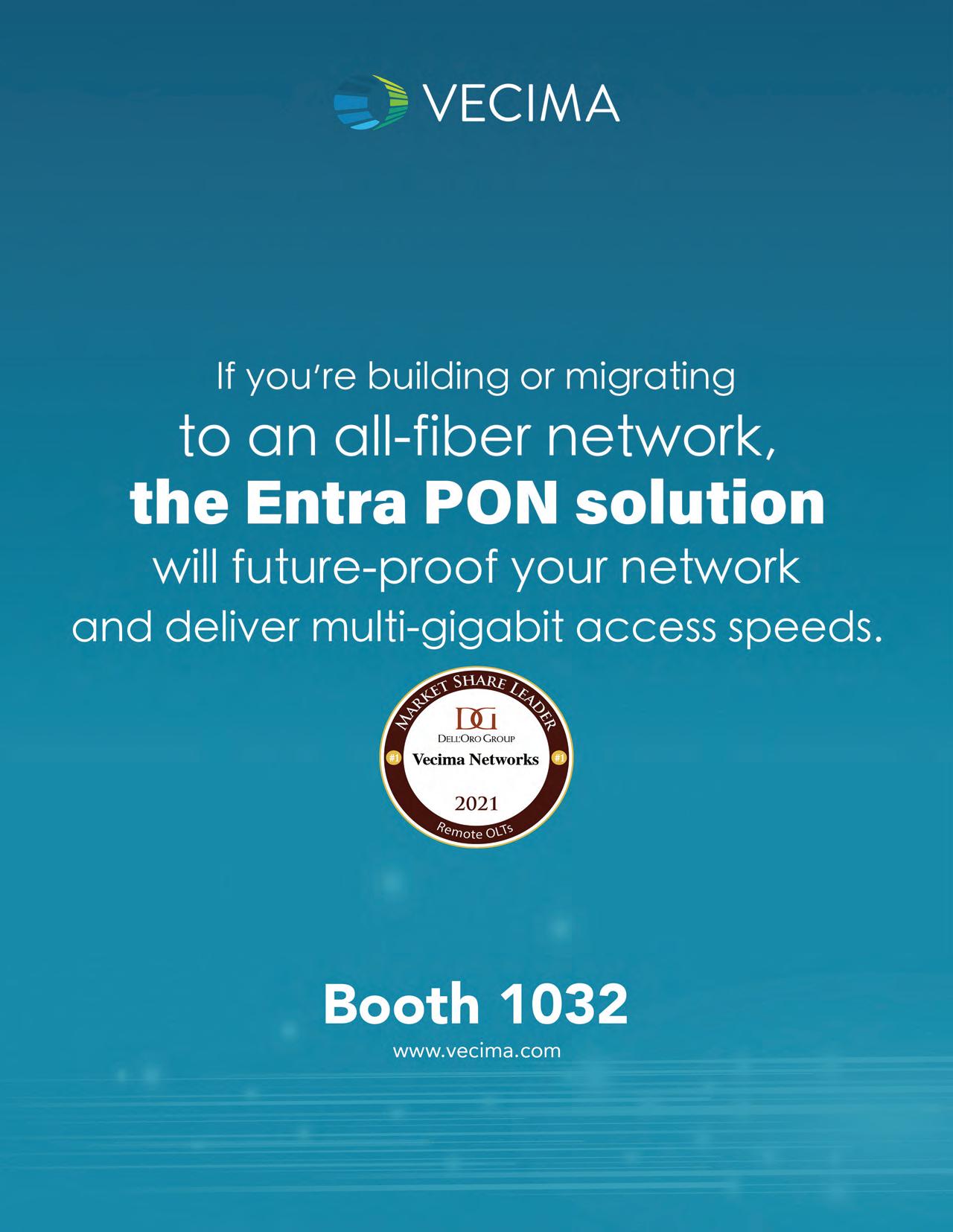



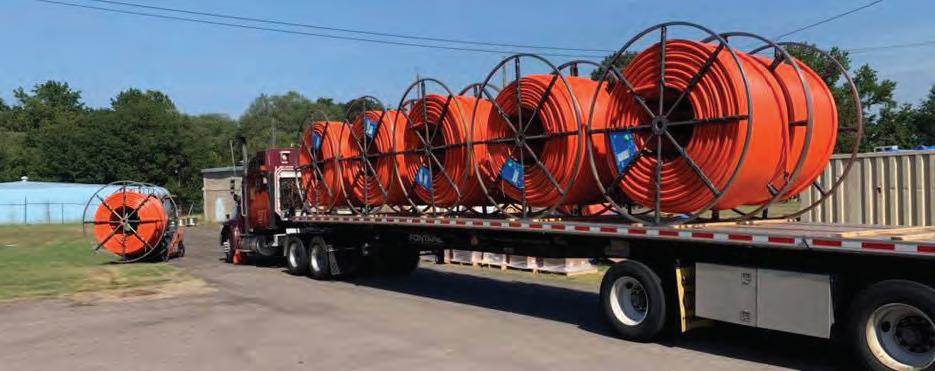
As 10 Gbps emerges as the latest performance standard for fiber networks, equipment manufacturers and service providers have started the process of figuring out what the next benchmark will be for the industry. Some favor 25G PON as the starting point for ratcheting up faster speeds while others believe it makes more sense to start at 50G due to a combination of economics and market necessity. Regardless of the winner of the 25G/50G debate, core network speeds will continue to be upgraded to support faster edge access.
Members in what could be called the “25G PON today” camp include AT&T, CableLabs, Cox, Ciena, Dobson Fiber, NBN, Nokia, and Zyxel Communications. These companies are among those that have joined forces to form the 25GS-PON multi-source agreement (MSA) Group to promote and accelerate the development of symmetrical 25G PON technology. The 52-member organization uses a MSA that enables the group to act as a de facto standards organization to define how a technology – in this case 25GS-PON – should be implemented to ensure basic functionality and interoperability across vendors.
The 25GS-PON MSA Group sees the standard as the natural evolution of XGS-PON. “We’re taking the
technology of XGS-PON and using the same basic technology,” said Ed Harstead, a Lead Technology Strategist in the Nokia’s Chief Technology Officer’s Office, Fixed Networks Division. “We’re just speeding it up by a factor of two and a half. The datacenter ecosystem has been shipping 25G bandwidth components at tens of millions of units for years now, so 25G PON has a straightforward path to low cost, eventually tracking close to XGS-PON pricing over time. Going to 50G PON is more of a quantum leap in technology.”
Moving to 50G PON requires two new technologies, optical amplifiers and digital signal processing, said Harstead. Both technologies add complexity and cost, putting 50G PON out of near-term economic reach for many years. Moving to 25G PON can happen quickly and covers clear use cases today in the enterprise, 5G transport, wholesale, and ultimately residential deployments when equipment costs come down.
Ciena has been involved with delivering optical network gear for over 25 years, so moving into PON is a natural evolution. “At its core, PON is an optical technology delivering packet services,” said Joe Marsella, Vice President, Product Line Management – Routing and Switching, Ciena. “It’s very much aligned with our core



Bring digital infrastructure to your community.

Broadband is a necessity many Americans rely on to communicate ideas and access information. However, for many rural and low-income urban areas, broadband remains out of reach due to a lack of infrastructure or social issues related to digital literacy and affordability.
Michael Baker International’s broadband planning services and solutions are designed to create a holistic approach to broadband planning, strategy and program execution regardless of the client’s implementation stage.

What are your broadband-related goals? We offer configurable and customizable solutions tailored to the needs of our clients.
Identify
Identify Unserved Locations
Roadmap Development

Stakeholder Engagement
Public Engagement
Michael Baker works with customers to identify their needs related to broadband and connectivity. Our professionals provide expertise informed by the entire broadband life cycle, enabling us to assist clients at any stage.
business. We haven’t historically been in the GPON game, but we made a decision a number of years ago to intersect the market with the inflection of 10G XGS-PON and GPON.”
The emergence of XGS-PON enabled Ciena to go beyond just offering enterprise and carrier services into supporting residential services as fiber-to-the-home took off within the U.S. and around the world. In 2020, Ciena rolled out a pluggable end-to-end XGS-PON solution that is easily upgradable to faster speeds.
“What we’ve done is future-proofed our XGS-PON solution for 25G when the technology matures to the point where it makes sense to deploy and scale it,” Marsella said. “There are 25G capable components in the market today, but the commercial models aren’t quite there yet to deploy at scale. It’s going to take a year or two to establish some specifications and standards to make sure we can do interop at 25G.”
Ciena is delivering a different hardware architecture approach than traditional PON vendors, enabling routing and switching on a port-by-port basis rather than a traditionally chassis-based OLT with line cards. This provides the service provider with more flexibility in configurating and allocating services.
“We call it universal aggregation. One port can be active Ethernet or active IP and the next port can be XGSPON. And ports can be 25G PON when the technology is available,” Marsella said. “This is a more flexible way, particularly in Tier 2 and Tier 3 markets where they’re trying to do lots of things with a little network when compared to a traditional PON model. We’re having success because it has a lot of space, power, and thermal benefits over the traditional large chassis.”
“Once you ship the [25G PON] silicon, when your look at the economics it makes sense verses what you are doing today in 10G,” Marsella said. “That’s why we think 25G PON will be deployed and deployed quite a bit. For 50G and 100G, it’s still hard to see in the near term. Typically, people build 10G ports that can go 25G, while 50G is closer to 100G in terms of technology. I think it’s a bigger step to go to 50G and I don’t see it in at least the next few years. It doesn’t make commercial or financial sense in the nearterm and it’s going to take a while in my view.”
Others disagree with 25G PON being the next step, arguing that 50G PON is the technology to invest in for the long haul, providing the basis to scale to 100G PON.
As residential applications surge the battleground for the underlying fiber technology is centered on 25G as a potentail building block. Source: Adobe Stock.

“Adtran’s position is that 50G PON is the next realistic step after XGS-PON for the global PON market,” said Ryan McCowan, Adtran Chief Technology Officer for the Americas. “There are a few reasons I don’t think 25G PON is as viable as 10G and 50G. It doesn’t solve mass market problems for applications and it’s too niche to get meaningful global volume. If you don’t get that, you don’t get mass market economic viability.”
McCowan cites the lackluster market reception of NGPON2 as an example of a “very cool” technology that didn’t get the pickup necessary to be widely accepted. “XGSPON was the choice of all the high-volume vendors and service providers, including the very high-volume Chinese service providers that drive so much of global PON volume,” he explained. “If you don’t have those operators on board, you are not going to get mass market viability.”
The technology of choice for those high-volume operators is 50G PON, McCowan asserted, even to the point of opposing ITU standardizing a 25G PON technology, leading to the creation of the 25GS-PON MSA Group to push for standards.
“Getting back to mass market problems for applications, 25G PON is being talked about for 5G small cell support and true 10 Gbps enterprise services,” McCowan said.
(cont. on page 54)
There are 25G capable components in the market today, but the commercial models aren’t quite there yet to deploy at scale. It’s going to take a year or two to establish some specifications and standards to make sure we can do interop at 25G
– Joe Marsella, Vice President, Product Line Management – Routing and Switching, Ciena.
Creation of the $42.45 billion Broadband Equity, Access and Deployment (BEAD) Program is a “good news, but—” situation for the states, territories, District of Columbia, and Puerto Rico. The good news is those entities will receive at least $100 million in grant money from the National Telecommunications and Information Administration (NTIA) that will be used to fund broadband programs for unserved and underserved communities.
Distributing the initial funds, managing grants, and requesting more BEAD grant money is the “but—” states face in the months and years to come. Established state broadband offices, and the many currently forming, face the challenge of scrutinizing applications, prioritizing projects, and allocating money fairly, while ensuring grants aren’t mismanaged.
Fiber Forward talked to stakeholders participating in the “State of the States: Ensuring Fiber Reaches Everyone” panel at Fiber Connect 2022 to get a ground-level perspective of the challenges and successes states are seeing as they gear up to close the digital divide. The panelists told us about the current organizational and administrative challenges in publicly funded broadband projects, areas where states are having success, and issues of concern in regulation, middle mile, supply chain, and workforce development.
Staffing, mapping, coordination, and getting access to more money were the top concerns expressed by the people we talked to. Creating and expanding broadband offices to handle the large influx of BEAD dollars is expected to be non-trivial.
“Most state offices have had two to three people (or less) passing out a few million dollars per year,” said Peggy Schaffer, Executive Director, Connect Maine. “In Maine, we have gone from $750K for infrastructure grants in 2019 to $400 million by 2023. That is a lot of volume, accountability, outreach, and prep work to get going.”
Schaffer counted herself fortunate heading up an organization outside of the state government given the fewer hurdles in creating positions and hiring staff. For organizations where the broadband office is a formal part of the state government, legislative approval is often required for such activities.
Mapping continues to be a big concern, with the FCC’s use of census blocks considered to be a major headache. “ISPs
and towns don’t engineer networks based on census blocks and people don’t choose homes based on census blocks,” said Schaffer. “States are struggling. The companies with the most accurate information will not share it or cannot share it because they don’t have the data either.”
Sorting out who does what between the federal, state, and local levels is a work in progress. “I still feel there is confusion about the scope of funding and responsibilities between federal and state grants on what is admissible and who grants can be allocated to,” said Michael Langlois, Chief Technology Officer, Calix. “What could be motivating is the stacked ranked of cities per state on their ability to offer high-speed symmetrical services so the local agencies, town, and communities feel peer pressure as well. This worked well eight years ago with Google creating awareness for Gigabit cities. “
Making sure there is enough money to deliver broadband to all of the unserved population is also raising concerns.
“We’ve got a lot of great opportunities with the funding states have received through ARPA and will be receiving from IIJA, and it’s obviously very helpful to be able to deploy these funds to provide service to unserved locations,” said Jessica Simmons, Deputy CIO for Broadband and Special Projects at Georgia Technology Authority. “However, based on the number of unserved locations we have in Georgia, we are going to need pretty significant matching funds in addition to federal and state dollars to have sufficient resources to bring service to all of the state’s remaining unserved locations.”
States with broadband offices are perceived as being ahead of the curve when BEAD money becomes available. Calix’s state fund web resource lists over 30 states who have proactively started broadband programs using state and ARPA funds.
“While planning and funding opportunities existed prior to its launch, the Virginia Department of Housing and Community Development’s Office of Broadband, through its creation in 2020, formed as the one-stop-shop for broadband in the Commonwealth,” said Alexis Carey, Spokesperson, Virginia Department of Housing and Community Development. “These ongoing efforts have placed Virginia in the driver’s seat to direct funding for welldesigned broadband projects.”
Communication and engagement are vital between states and other parties. “It is encouraging to see States engaging with ISPs and their stakeholders, including communities, to close the digital divide,” said Langlois.
Schaffer agreed. “States know it’s a heavy lift, for most of us, far above our weight class. But we are working hard and are committed to doing this right. We are working diligently to hear all the sides of this conversation and meld it into a plan. States are hiring wicked smart, committed people who want to do this right. We need our partners of communities, providers, and customers to come to the table with an open heart, hands to help and patience to get it right.”
Mapping is a key component. Many states are being proactive and determined to have better data on areas where people need broadband services the most, more accurately than the FCC can currently provide. “I think most states now really understand the importance of having their own location-level map, and a lot of states are working quickly on this effort,” said Simmons. “Georgia is lucky to have one of the best location-level maps in the country and having this resource allowed Georgia to conduct our ARPA broadband grant quickly and strategically.”

Everyone seemed to agree that federal agencies should provide flexibility in building networks to facilitate the best way to serve the most people while providing the best technology available.
“NTIA’s BEAD performance requirement to provide service at no less than 100 Mbps/20 Mbps uploads is too low,” said Langlois. “Congress directed the NTIA to prioritize higher speeds. I recommended that the program assigns significantly better scoring to those applicants that propose
to deliver higher levels of service at symmetrical levels (i.e., 100 Mbps symmetrical service up to Gigabit symmetrical service). This will avoid the incremental future rebuilds that ultimately cost more over time.”
“[Federal agencies should] understand that fiber projects should build a high-quality connection to everyone and that is the most efficient way of building a network,” Schaffer said. “Inability to serve the underserved that are on the route to the unsevered is just dumb. No one builds a network that way and we shouldn’t fund projects that way. Yes, getting broadband to unserved areas is a priority, but let’s build the network smart, build it right, build it to everyone.”
While a majority of the current focus is delivering service to the last mile, Schaffer and Simmons feel they may need to do some building upstream. Georgia is reviewing its middle-mile needs and plans to apply for the appropriate NTIA grant money when it becomes available.
“We are including a middle mile strategy in our plans in part because our focus is the cost to the consumer,” said Schaffer. “Lowering the cost of getting there with open access, nondiscriminatory middle mile, peering, and other strategies is central to how we lower the costs of a project from bow to stern.”
Langlois feels more strongly. “A broadband service provider’s offering to the end user is only as good as the reliability of the middle mile. Operators across the country have been rolling out gigabit service at a rapid pace only to find that the link to the internet exchange point is not sufficient. The infrastructure bill funded $1 billion for middle mile broadband infrastructure projects which starts to
(cont. on page 43)
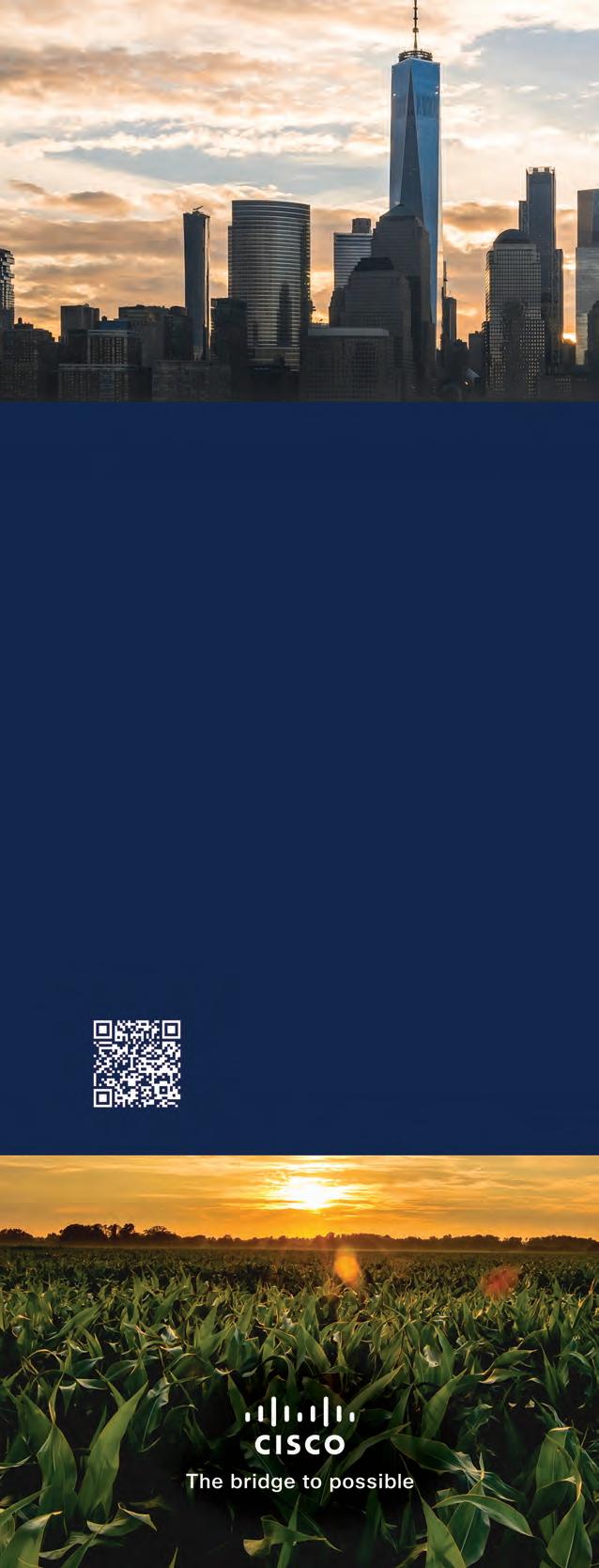

In the last two years, we have seen a massive deployment of fiber broadband connections in Latin America. According to the latest study by the FBA LATAM Chapter and IDATE, homes passed with fiber surged to more than 280 million with 28 million subscribers.
Recent fiber growth rates of homes passed and subscribes with the upward trends in Graph 1 below.
In terms of Homes Passed and Subscribers (2012-2020)
Alternative network providers, known as “altnets,” contribute more than 70% of the homes connected to the Internet by fiber in the region, especially in markets such as Brazil, Mexico and Colombia.
Graph 2 shows the relative importance of altnets connecting homes with fiber compared to incumbent service providers, and the relatively small impact to date of utilities.
Market view/September 2020
for investment in large-scale middle mile networks, often complicated by the harsher environment where there are few subscribers to economically justify last-mile investments.
Argentina, Brazil, Chile, Ecuador and Colombia have made better progress given the involvement of the entire telecommunications ecosystem, including strong local supplier performance, municipal support, and nationally-funded fiber programs that specifically target low-density areas with fullfiber connectivity.
(* Homes passed / Households)
The presence of altnets is especially impactful in small towns, where traditional large telecom companies aren’t as interested because these areas are less profitable.
Among the 18 countries covered in the latest FTTH Panorama - Latin America, only seven have more than 50% coverage (see Graph 3). Latin America continues to have a significant digital divide due to geography. In Andean countries such as Colombia, the topography makes it difficult to deploy middle mile fiber for connecting towns, while in Mexico, Brazil and Argentina, the length of the country increases the need
FTTH in the region will be complemented with the use of 5G Fixed Wireless Access (FWA) technology to enable broadband access in areas where fiber can’t currently be economically deployed. The arrival of 5G FWA should follow the implementation of mobile 5G in the region. This will likely take place in 2025, determined in part by the market adoption of mobile 5G after deployments and real-world trials begin in 2022.
For fixed operators, 5G FWA will accelerate the implementation of the last mile in sparsely populated areas, accelerating the provision of high-speed access, and for mobile operators, it is the gateway to the fixed internet market. However, buildouts of mobile 5G services will require deployments of fiber to support them in point-to-point connections in the middle-mile infrastructure.
GPON is being highly implemented in the region, making Ethernet P2P solutions less common. The GPON implementation format uses two levels of distributed splitting
for most providers. One segment is carrier neutral operators that in many cases use the topology of centralized splitters in cabinets or mini-HUB type NAP boxes, which can deliver both point-to-point and GPON multipoint services. This arrangement provides service flexibility for both dedicated enterprise-grade and residential customers out of the same cabinet or mini-hub.
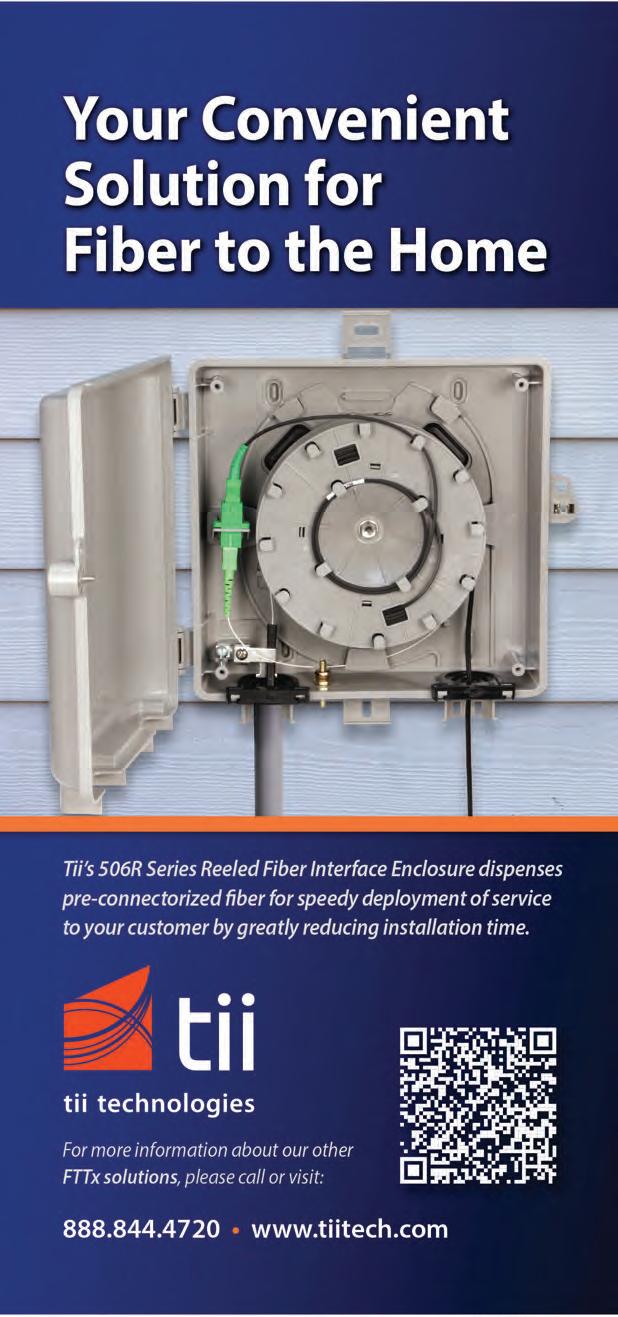
Aerial networks represent 70% of total fiber deployments due to rapid deployment and cheap implementation. This massive deployment on poles has brought great concern with the visual impact of streets and neighborhoods, maintenance of the operation, and difficulty of construction throughout the region due to restrictions on fixing boxes to poles.
Implementation of aerial networks is constantly changing as operators seek simplified methods to reduce installation time. There is also a trend towards pre-connectorized solutions with enable a more tailored CAPEX and offer greater implementation flexibility compared to traditional solutions.
Currently under development is the process of updating and controlling fiber deployments, essential in the coming years.
The demand for data and bandwidth has intensified over the past year, leading to a significant increase in FTTH networks in Latin America. More LATAM carriers are focused on creating full-fiber networks to respond to the continued traffic growth. National authorities are equally involved in accelerating broadband deployments by putting in place digital agendas and national broadband plans designed to accelerate fiberbased network deployments.
On the technology side, the use of less intrusive and faster deployment methods in cities and neighborhoods, with the adoption of the use of neutral networks and the implementation of exchange agreements, has helped drive the development of FTTH.
We can conclude that the entire telecommunications ecosystem in the region has intensified its efforts towards full fiber connectivity and that the pandemic accelerated the deployments. Further, national authorities are actively engaging in the digital transformation, with revised national programs and relevant policy framework to promote fiber expansion.
Finally, for network construction, pre-connectorized technologies have become a great ally for rapid construction, flexibility, and a more tailored CAPEX.
As an organization focused on promoting the acceleration of fiber deployment in the region, the Fiber Broadband Association LATAM Chapter continues following these changes and processes closely to analyze the impacts and discuss and educate the industry in Latin America.
address this problem, but I feel that this level of funding is not sufficient. NTIA should assign some of the $42.5 billion BEAD program to middle mile.”
Everyone is gathering information from service providers about potential supply chain issues, with some impacts already being seen.
“We have heard that it is taking longer to get fiber and prices are increasing; however, some [Georgia] providers have a lot of material on hand, so it just depends,” said Simmons.
“Several [Virginia] internet service providers have noted the difficulty to secure telecommunications equipment and the increasing lead times from purchase to delivery,” said Carey. “These supply chain issues are voiced by both large and small internet service providers across multiple technology types, but especially those ISPs building fiberoptic broadband networks.”
The workaround for supply chain issues will vary from state to state, with Virginia being proactive in its contract
Virginia is forming several partnership models for workforce development. Blue Ridge Community College and the Central Shenandoah Planning District Commission have partnered with other groups to launch a broadband workforce training program. Discussions of similar programs are currently taking place in other areas of the Commonwealth.
Maine is taking a similar approach but with a regional layer added on top of it. “We are talking with our Community College System, our Vocational Technical High Schools, IBEW, CWA, and our provider community about strategies, training, and how to best move people into this field and then provide a career path within this field,” said Schaffer. “We are also beginning to work with Vermont and New Hampshire which shares the workforce in the region.”
Interviewees admit that keeping broadband projects running will depend on long-term business models than third-party funding.
handling. “In December 2021, Virginia announced a $722 million investment that will produce universal broadband access for 70 counties and cities,” said Carey. “To allow these ISPs to stay ahead of supply chain constraints, pre-authorization of costs for grant-related activities was allowed for awardees upon request. This pre-authorization enables ISPs to purchase materials to have ‘on-deck’ and seek reimbursement for those costs of materials during project implementation.”
Schaffer is looking at more creative options. “Maine does not make fiber or GPON devices, so we don’t have a lot of control over that part of the chain. Bulk purchasing across New England is an idea we have floated, giving us potentially more buying power, but there are lots of hurdles for multiple states to do this together.”
Workforce challenges are also anticipated with everyone equally concerned and looking to technical schools and community colleges to create more skilled fiber technicians. “Similar to the shortages cited around telecommunications supplies and materials, internet service providers (ISPs) have also noted labor shortages to build broadband networks,” said Carey. “Virginia communities have seen an increase in the costs of crews needed to build networks, but this has not led to project delays.”
“Hopefully, projects in the state don’t encounter sustainably issues, but it’ll ultimately be dependent upon what the projected subscription rates were for the business models that were created and if the projects meet or exceed those goals,” said Simmons.
“There is a significant history in the private sector of not always maintaining and upgrading assets to meet economic changes and innovate in the space,” Schaffer said. “Ask any paper mill town in Maine about the impact of taking profit off the top and not reinvesting in the infrastructure. Part of the reason we look at take rates, revenue strategies, and operating expenses for five years in our grants is to make sure there is enough revenue to keep the operations up to date and running.”
Fiber is cheaper and easier to run than a legacy copper or coax network, but there are some FCC funding policies that should be revisited. “Many ILECs who are not upgrading their plant to fiber are still getting funding from the USF to run those old networks,” Schaffer said. “That funding needs to be reexamined and addressed to meet the new reality that federal infrastructure money is going to change the playing field. Funding that flows to maintain the legacy systems should be reexamined based on the cost benefits of fiber networks.”
Hopefully, projects in the state don’t encounter sustainably issues, but it’ll ultimately be dependent upon what the projected subscription rates were for the business models that were created and if the projects meet or exceed those goals,
– Jessica Simmons, Deputy CIO for Broadband and Special Projects at Georgia Technology Authority
To help State Broadband Offices leverage the historic federal funding programs in place, the Fiber Broadband Assocation (FBA) is bringing its considerable institutional knowledge and member experience on the road. FBA is hosting five Regional Fiber Connect Workshops in 2022, helping communities across the country get access to the information and resources needed to deploy fiber broadband infrastructure with federal and state funding and maximize the opportunities ahead to close the digital divide. These workshops are single day events designed to share best practices, grant writing advice, compliance and resource management tips, and provide networking and educational resources to the state broadband offices, as well as other members of the fiber broadband ecosystem.
FBA has hosted two successful workshops to date. Taking place in Baton Rouge, Louisiana on March 23rd, the first Workshop had 172 total attendees from 90 different organizations including network operators, vendors and suppliers, educational institutions, state and city broadband infrastructure offices, and other industry associations. Executive Director of ConnectLA Veneeth Iyengar, the featured speaker, gave an insightful talk about Louisiana’s progress in closing the digital divide regarding access, affordability, and digital literacy.
Nearly 150 people attended the Regional Fiber Connect workshop in Providence, Rhode Island on April 19th, representing more than 80 different organizations in Rhode Island and the surrounding states. The opening keynote was delivered by Rhode Island Lieutenant Governor Sabina Matos, followed by Daniela Fairchild of Rhode Island Commerce. Both speakers provided valuable insights into the importance of broadband access to Rhode Island and the region for healthcare, public safety, education, and economic development. The closing keynote was provided by State Representative and Chair of the Rhode Island Committee on Innovation, Internet and Technology, Deborah Ruggiero.
Both workshops included “The Community Broadband Assessment” kick-off general session. Presented by Lit Communities. The session was focused on the first step in bridging the digital divide and provided details on assessing a community’s broadband needs and how to develop a strategy to meet them.
FBA President and CEO Gary Bolton led a session on the Broadband Infrastructure Playbook, the Association’s howto guide for implementing BEAD and other broadband
deployment programs. The Fiber Funding panel was especially well received, with CTC President and FBA board member Joanna Hovis and City of Boston Broadband Director Michael Lynch providing insight for communities looking to secure federal and state monies.
Other important sessions included “Building Community Support & Political Goodwill,” “The Value and Impact of Research & Brand Positioning,” “Industry Trends & Best Practices,” and “Marketing Strategies for New Product Launches” were presented by FBA member company representatives and other subject matter experts.
FBA is clearly meeting a need based on the success of the first two Regional Fiber Connect workshops and would like to extend a special thank you to all sponsors, exhibitors, and speakers. Delivering these workshops would not be possible without the support and participation of those organizations and the individuals involved.
The feedback from attendees at both sessions was overwhelmingly positive and FBA looks forward to the remaining workshops scheduled for Nashville, Tennessee during Fiber Connect in June, Frisco, Colorado in August and Columbus, Ohio in November.



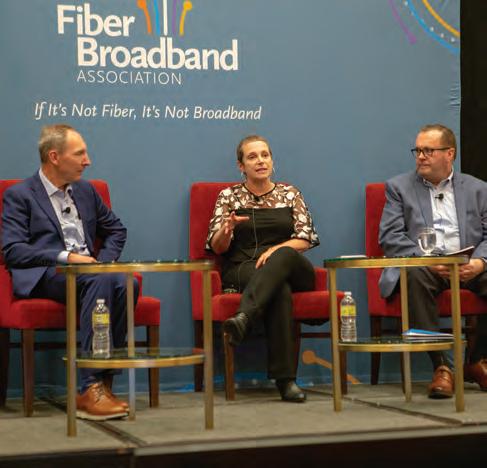






The digital divide within the education system came into sharp focus during the pandemic. Remote learning jumped from a niche tool to mainstream practice overnight, with students, teachers, and school districts forced to adapt to a new reality. Today, classrooms have reopened and the role of reliable high-speed broadband in education is distinctly clear, with communities and civic leaders recognizing the need for all students to have unfettered access to connectivity.
Ji Soo Song, Broadband Advisor at the U.S. Department of Education (ED)’s Office of Educational Technology (OET) advises policies and leads initiatives to expand equitable access to high-speed broadband, connected devices, and transformative learning opportunities empowered through technology. Song serves as the principal contact for interagency l collaborations to advance digital equity, including serving as ED’s representative with the American Broadband Initiative. He also provides subject matter expertise on digital equity to Department-led external capacity building efforts.
Song will be speaking as part of the Fiber and the Social Good panel during the general sessions at Fiber Connect 2022, discussing broadband, education, and the Department’s role in closing the digital divide. Fiber Forward sat down with him to discuss OET’s role in broadband and efforts surrounding it.
I can break out the Department’s role in three parts: guidance on strategy, direct investments, cross-agency coordination.
With strategy, during the pandemic we published several different resources outlining the role that state and local education agencies – our stakeholders – can play in closing the digital divide. If you go on the OET website, you can find our Home Access Playbook, which describes seven different strategies for what state education agencies can do to deliver at home connectivity. That can range from collecting better data about the quality of connections that a student’s household has all the way to developing professional development and the human capacity behind how technology gets used by the educator. We also released our Wireless Brief which looks at six different rural school districts, and what they’ve done to set
up wireless networks in their community as one solution that they’ve taken to close the digital divide. There are six different case studies showing examples of how a more localized approach could be done.
With the Bipartisan Infrastructure Law now in place, we’re currently working on a publication to guide investments that lead to equitable adoption in learner communities furthest from digital opportunities. That’s our DEER (Digital Equity Education Roundtables) initiative.
The second piece I mentioned was investments. I represent the ED on the American Broadband Initiative’s Federal Funding Workstream. One of the deliverables of that interagency group is a publication that guides stakeholders on the range of federal funding opportunities that can be used to support broadband and broadband related activities.
A lot of different ED programs were included in the FY21 version of the guide. We’re doing a refresh for FY22 programs, so folks can be on the lookout for that.
The third piece that I mentioned was cross-agency coordination. There are programs across the federal government from other agencies that require support from ED so that it can positively impact our educators and students.
One big example of cross-agency coordination is around the Affordable Connectivity Program (ACP). We collaborated with the FCC to develop FAQs that will be relevant for schools and districts regarding the program. We’ve included information about the ACP in our outreach to eligible stakeholders For example, we sent emails to Pell recipients and are planning a webinar for those eligible for the ACP.
We’re also currently working on a few resources that might make it a little easier for schools and districts to help eligible families sign up for the ACP.
It sounds like ED has direct funding that can be applied to broadband projects in unserved/underserved areas.
I’ll clarify that. The Department doesn’t have a program that’s specifically designated for “broadband projects.” But there are several programs that have flexibility that can be used towards project-related activities, if it fits within the broader goals of that program. You can find those nuances in that FY21 Broadband funding guide that I mentioned before.
For example, the Student Support and Academic Enrichment Program has three big buckets: well-rounded education, safe and healthy schools, and effective use of technology. Broadband and digital equity could fit into ‘effective use of technology,’ and we talk about those nuances in the federal funding guide.
Note: The guide can be found at https://broadbandusa. ntia.doc.gov/resources/federal/federal-funding
What sort of evolution in thinking has there been in educational broadband access over the past 24 months?
The pandemic really transformed what we should be thinking about when we discuss tech-enabled learning. Before the pandemic, there were some innovators in the field, but learning was largely bound by the four walls of the classroom. During the pandemic, a lot of schools realized that learning doesn’t have to stop when students leave that physical classroom.
I think we can build on this momentum and broaden our horizons on what is possible with technology.
With that vision and possibility comes a lot of different responsibilities and challenges. Throughout the pandemic, more of us realized it’s not just ‘We give devices and the hotspots, and we are ready to go, we can just take our curriculum and move it to an online environment.’ The non-exhaustive list includes availability and quality of an internet connection because students can’t be doing what we’re doing here [video conferencing] if they don’t have adequate bandwidth and adequate equipment. It can also include educator capacities to provide effective learning
experiences with technology. Educator preparation programs can better train educators on effective digital learning practices.
We also need to address the role of parents and caretakers in supporting that effective learning environment and the social, emotional, and mental health supports at times when students may be physically apart from each other or from educators and counselors.
Is it fair to say the 25 megabits down 3 megabits up broadband standards are outdated for 2022?
Yes, obviously with activities like video streaming or video conferencing that take up a lot of bandwidth and require higher speeds.
It’s important we not just consider the availability of broadband but the quality and reliability as well. OET has held multiple listening sessions over the past couple of months with members of the public. Time and time again, we’re hearing stories of families that have either multiple children or live in multi-family/multi-generational households. If multiple folks are online at once, the bandwidth simply isn’t there to reliably connect to the internet and participate in activities that require it.
It’s good to see the BEAD law does set a higher standard for higher bandwidth, higher speeds than the 25/3 norm. We need to be setting our horizons broader around what we mean when we say reliable high-speed broadband.
After we plug in fiber into unserved/underserved communities, how do we plug in people?
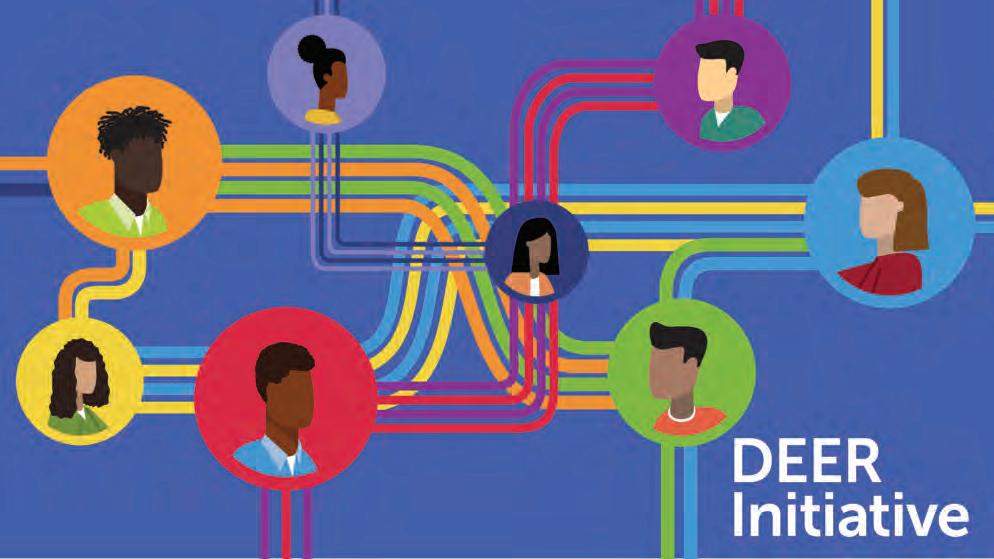
This is the goal of the DEER initiative, the people side of the equation. There’s a lot of large, historic funding mechanisms to put the physical infrastructure in place so broadband is available and affordable, like the Affordable Connectivity Program (ACP), which provides subsidies for qualifying households on their monthly communications bills. The third piece of the equation is adoption. Availability and affordability are critical pieces of the puzzle, but we can’t make those standalone solutions.
Adoption issues, from what we’ve heard through our listening sessions, can vary largely from digital readiness and digital literacy skills all the way to awareness of existing programs and digital inclusion resources. For example, the Emergency Broadband Benefit, the precursor to the ACP, is a great program that started last year. Less than 25% of available households were able to apply for it and one of the biggest reasons why they didn’t was because people didn’t know that it existed or didn’t know how to sign up for it.
We don’t often think about those types of human barriers when discussing digital equity. This is where OET is investigating more. We’re right now conducting a series of roundtable conversations with groups and organizations that represent communities furthest from digital opportunities to hear about those human-level barriers and what strategies there might be to work around them.
Through our various listening sessions over the past couple of months, we’ve heard many communities look to schools as trusted hubs of information and resources. It’s critical, as you said, that schools become involved with solutions. At the same time, we also recognize that schools have several items on their plate that they’re dealing with right now.
Partnerships with different sectors are going to be critical here. It’s going to take some time for infrastructure investments to create impact. What do we do to help students in the meantime? You mentioned libraries. Libraries were important during the pandemic and will continue to be important, providing community access as well as other resources like digital literacy training. For example, the Idaho Commission for Libraries was able to outfit their 50 or so facilities with the capacity to provide a wider radius of access so folks in the community would be able to use the library’s network for different digital learning experiences.
Also, for learners and families that are mobile, like migratory students or students experiencing homelessness, hotspots will continue to be important to some degree to provide access while more permanent solutions like wired or fiber access are put into place.
– Ji Soo Song, Broadband Advisor, U.S. Department of Education (ED)’s Office of Educational Technology (OET)
What are some examples of innovators that are doing good work in this space? We’ll be using that information to put together a guidance resource for states that are leading the development of their digital equity plans. We know they’re going to be focused on availability and affordability, and that’s critical. We want them to also be thinking about these human-level barriers. How can we develop some great community partnerships to make sure we’re able to realize the real potential of these investments?
We recently read a study from Brookings that compared broadband availability and broadband adoption, and its impact on the economy of a region. What they found was that inclusive broadband adoption was a better predictor of economic growth than just the availability of broadband. Taking that sort of evidence into account, we have to make sure that we’re navigating those human factors as well. This is the core of our DEER initiative.
Are we at a “new normal” where schools recognize they have to be involved in delivering broadband to all of their students rather than relying on a community safety net of libraries and public hotspots?
So yes, there’s a role for schools to play. They can’t just exist in a bubble and be everything for the community. A coordinated partnership and collaboration network needs to be placed so schools have a role to play as a trusted hub of information resources, but they’re not doing this work alone. They need support working with their library systems, community-based organizations, philanthropies, ISPs, edtech companies, and state and local leaders.
Workforce development is a big concern within the broadband industry, especially with training and certifying fiber technicians. Is this an area where the ED can contribute?
ED is engaged in an interagency workgroup led by the FCC and the Department of Labor, focused on developing recommendations for Congress on building the 5G and telecoms workforce necessary to implement all the different programs within the Bipartisan Infrastructure Law. The big priority is directed to identifying what policies or programs we are going to need to put in place to make sure that the workforce and human capacity is there to effectively implement all these different dollars and programs that were appropriated.
We’re right now conducting a series of roundtable conversations with groups and organizations that represent communities furthest from digital opportunities to hear about those human-level barriers and what strategies there might be to work around them.
Back in 1896, the citizens of Lafayette, Louisiana voted to build their own municipal water and electrical plant, creating what is now the Lafayette Utilities System (LUS), a department of 460 people in the local government that delivers one of the lowest residential electric rates in the state. LUS added fiber to its portfolio in 2009 and is now moving beyond the municipality’s traditional boundaries to provide high speed broadband services to its neighbors in the surrounding Acadiana region, some of whom are in desperate need of modern, reliable communications infrastructure.
“We are eager to move forward with providing broadband services in additional parishes, including the city of Ville Platte which was recently ranked as having the fifth slowest average internet rate in the U.S.,” said Ryan Meche, P.E., Director of LUS Fiber. “Today we have areas struggling with completing credit card transactions and even reliability of their 911 centers due to technology limitations. We are excited to play a role in ensuring that residents and businesses have equitable access and the opportunities they deserve.”
An independent study by the region’s Acadiana Planning Commission (APC) in 2021 found that nearly 25% of businesses and a third of households in the seven-parish area lack access to reliable internet. Without a healthy economic base and incumbent carriers unmotivated to fix or replace legacy copper facilities, the residents and
businesses surrounding Lafayette have long needed a reliable telecommunications solution to provide basic quality of life services to the area. LUS Fiber teamed with APC and local cable provider Allens Communication for a fiber-to-the-home (FTTH) initiative. Building out from LUS’s existing infrastructure, service would be expanding to unserved rural homes in adjacent unserved census blocks with the project completed within a year.
With its partners, LUS Fiber secured a $21 million grant from NTIA’s Broadband Infrastructure Program for deploying over one million feet of fiber to the communities of Ville Platte, Church Point, Eunice, Mamou, and Basile, providing internet, video, and phone services for residences and businesses. The new build will include service to 3,700 businesses, 19 schools, 12 fire stations, nine police stations, four hospitals and two local government buildings, according to the APC grant application.
The grant was very important not only to the citizens who will benefit from it but to the White House. Vice President Kamala Harris visited the area to highlight the national need for broadband in March of this year. “Far too many of our fellow Americans cannot afford the cost of a high-speed internet plan,” the Vice President said. “This community, which is why I am here, is all too familiar with these challenges.”
Getting into broadband networks didn’t come easy for LUS. The organization first sought to build a municipal fiber

network in 2004 but had to go through a multi-year legal battle on the city’s right to sell bonds to fund the network. After several rounds of litigation leading to a unanimous decision by the Louisiana Supreme Court, the city was finally able to sell $125 million in bonds in 2007 and started construction in 2008.
Since launching service in 2009, LUS Fiber has built a network passing over 50,000 homes in the city of Lafayette, delivering residential and business services to its customers, including voice, phone, and internet. Nokia, formerly Alcatel-Lucent, is the solutions integrator for installing and maintaining the network equipment, providing a single point of contact if something breaks. The initial network was created using GPON and multiple 10 gigabit rings around the city, with an upgrade actively underway to NG-PON with 100 Gbps core network speeds.
As a community-focused organization, LUS has focused on better customer service. “Our customers trust us to keep them connected in today’s digital world,” Meche said. “We recognize that access to reliable, high-quality broadband service is imperative for communication, online learning, telehealth, managing business, and more. We’re proud of our 95% customer satisfaction rate showing that local roots really can provide an edge over the larger competition.”
The creation of LUS has improved quality of life not only for its users but for the entire community. Incumbent providers had to improve their services and lower their prices, driven by LUS’ competitive offerings of broadband services as low as $25 per month, 1 Gbps service for $70 and 10 Gbps service for $300 per month.
Higher speeds have enabled the region to keep existing businesses and attract new ones to the area. The local economy, catering to the oil drilling industry, was very energy focused. Bringing in fiber has diversified the business mix, attracting IT service providers such as CGI and bringing in a more technology-centric workforce.
The LUS Fiber network expansion is expected to have an impact far beyond the next few years. “To local communities, high-speed broadband is truly transformative – decreasing the out-migration and growing businesses by creating environments where generations of children can stay in their hometowns to work or even work remotely for businesses across the globe,” Meche said. “We don’t take this lightly – we understand the positive impact this can have for families and our economies.”
In addition, LUS Fiber is creating careers for the area through its latest network build. “Our expansion will pave the way for economic development for our entire region,” said Meche. “We will be bidding the work for the build-out, creating local construction/operation jobs. We’re working with the local community colleges to create a training pipeline for fiber techs and installation techs. This large telecom boom is a win for us all, and the sky’s the limit for what we’ll see in the future.”
Holland, Michigan, can trace its fiber broadband roots back decades. While it’s not quite as old as the town’s annual Tulip Time Festival which started in 1929, it is enough to lay claim to the nation’s first open access fiber network. It’s had a slow and steady organic growth since 1992, but the status quo is changing as the community realizes the holistic value of highspeed broadband and has begun to push for an expansion to all residents in the city.
Today, Holland Board of Public Works (BPW) provides services to over 1000 locations, made up primarily of businesses, located throughout the city, The network is currently providing gigabit PON services and targeting an upgrade on its backbone network of 20 nodes from 10 Gbps speeds to 100 Gbps as part of a larger fiber project supported by the citizens to deliver broadband to every address in the City of Holland.
“We built our fiber network first and foremost to service the utility and second to serve whoever had a need for it,” said Pete Hoffswell, Holland BPW Superintendent of Broadband Services. “We decided as a city to make any extra capacity we have available to the community through an open access network. We’ve connected the public library, hospital facilities, and provided fiber services to the school district.”
Holland’s steady network growth, aided by network equipment suppliers including Nokia and Extreme Networks, filled other needs as they arose, supporting businesses that couldn’t obtain connectivity by any other means. Six partner ISPs leveraged the city’s open access network to provide service to their customers.

By 2016, the network philosophy of ‘expansion as needed’ was called into question by city leaders. “We started having conversations about our successful and sustainable network growing pretty slowly and organically, but it’s not serving the greater community,” Hoffswell said. “We were challenged by the city council who had cited broadband development as priority one for several years.”
BPW hired CTC Technologies to conduct a feasibility study on delivering fiber to the home. The utility also conducted some pilot projects, providing open access services to a new development on the south side of town and turning up a highdensity fiber deployment in the downtown area using Calix GPON technology to deliver broadband to small businesses, restaurants, apartments, and condos in 100 buildings. “The downtown pilot has been very successful,” remarked Hoffswell. “The city says ‘That’s great. When are you going to build the next neighborhood?’”
In 2020, the Holland BPW and City leadership established a task force to figure out what the next steps could be to expand Holland’s broadband network. It engaged in a listening tour, working with constituent groups such as senior citizens, health
care, education, special needs support, property owners and real estate developers, to brainstorm and find out what features would be important to them.
“We had a hypothesis that fiber to every single home in the city is a valuable investment,” said Hoffswell. “We wanted to go through the process of exploring that with the community in a community-based decision-making model, something the City and Holland Board of Public Works have used successfully several times, most recently by replacing our old coal-fired power plant in the middle of the city with a new natural gas combined-cycle power plant.”
Through that engagement process, the City and BPW came up with several attributes that they felt its expanded network should have, including reliability, affordability, speed, choice in internet service providers, and availability for all. “The value of a universal network was greatly increased with the onset of COVID,” said Hoffswell. “Our community had to work and learn from home more than ever before. Fiber to every home would be a great enabler.”
A survey conducted by Hope College for the Holland Broadband Taskforce found that 65% of the community agreed the City needed to invest to ensure sufficient access by all, providing a greenlight for BPW to move forward with a more proactive network expansion. City leaders met in March 2022 to discuss funding models for the network, with several expressing preference for the estimated $24 million in core infrastructure improvements being funded through property taxes while residents and businesses would pay for individual drop connections. Other options include simply rolling the cost of the drop connection into customer service rates, enabling BPW to recover costs more quickly, and building out the network based on the demands of neighborhoods.
Providing connectivity to the city’s 14,000 homes will cost around $24 million to upgrade and expand the core network, along with roughly $6 million for drops to connect 51% of the homes passed. A vote on property tax funding is expected to take place in August while Holland has also proposed allocating some ARPA funding for broadband development.
Hoffswell noted that IIJA BEAD funding is unlikely to be available since Holland doesn’t meet the definition of an unserved or underserved community. Some other federal opportunities for funding upgrades may be available, but grant funds aren’t a requirement to move forward. “Through the community decision making process, we feel that an investment in our community is an investment by the community and a [property tax] is the right way to go,” he said. “We don’t need to rely on federal dollars to do this. With the August 2022 vote, it is ultimately a decision by the community to invest in a ubiquitous fiber infrastructure for Holland.”

You shouldn’t have to navigate funding, building, or servicing a fiber network on your own.




We’re guiding American communities across the digital divide —and we want to serve yours next.
“Our partnership with Lit Communities is a great impact to economic business development within Medina County and allows us to address the residential and small business entities that we could not previously serve.”

 David Corrado, CEO of Medina County Fiber Network
David Corrado, CEO of Medina County Fiber Network
(continued from page 37)
“Certainly, they are real applications, but I don’t think they are large enough to drive mass market adoption for 25G. If you connect every single business premise in the United States with 25G PON, it wouldn’t drive very much in terms of the global PON volume needed to drive down costs and create large scale adaption.”
Adtran’s view is that exceptional applications such as 5G small cell and 10 Gbps enterprise services are better serviced with a different technology approach, using point-to-point wavelengths over the existing PON ODN infrastructure.
“If you can overlay 10G or 25G wavelengths for those exceptional use cases and you net that out, on average you might have one or two of those kinds of users per PON,” McCowan said. “Driving a new PON technology just doesn’t make sense for that kind of volume. Let’s take advantage of being able to reuse the fiber infrastructure already out there for residential and handle those exceptional cases with wavelength overlay. I can take conventional DWDM Ethernet optics and share those over the feeder fiber that the PON is riding on and break them out before you get to the splitter. That way you get your cake and eat it too because you haven’t used any additional fiber, you are reusing the feeder fiber that goes out to the splitter location.”
McCowan believes that using XGS-PON will continue to serve residential and small business use cases through the end of the decade with 50G coming into mass market availability around the same time, based upon the historical shift from GPON to XGS-PON over the past five years.
“If I look at what I’m seeing on the silicon side and the optics side today, and the 50G components coming together, we’ll see the first trailblazing field deployments in 2025, maybe 2026,” McCowan stated. “It took about four years from XGS-PON’s first deployments to it really taking off, so that gets you to 2029 on 50G PON when it becomes mass market.”
For 25G PON or 50G PON to be economically viable, it will take tens of millions of ONT units produced per year to make a significant impact. “The last few years we’ve been right around or a little north of 100 million ONTs a year globally,” McCowan said. “You’ve got to have some significant fraction of that market to meaningfully move the economics. The tipping point is probably somewhere between a million and 10 million a year. If you’re doing less than that, it’s a science project.”
McCowan noted that volume and costs for new ONT technology is driven by the total volume of optics and the availability of silicon from multiple vendors. “Is there enough volume to attract multiple silicon vendors?” he said. “Adtran saw the same dynamic play out in ONTs over the last three to four years. We were doing early implementations with FPGAs, then there was one silicon vendor in the market.
When two to three were available, everything came down in price which leads to a virtuous circle for adoptions where equipment gets less expensive, and so the volume goes up, which also works to make everything less expensive again. That’s why XGS-PON has done so well and why NGPON2 has not.”
Regardless of what the next fiber speed is at the edge, equipment manufacturers are prepared to supply the core network gear to support it. Speaking at an FBA “Fiber for Breakfast” webinar in April, Ciena’s Chief Technical Officer Stephen Alexander discussed the evolution of network hardware since the manufacturer started shipping commercial DWDM equipment in the mid-1990s. In those early days, it would take 10 full racks of gear to provision 400 Gbps of bandwidth.
“Fast forward to 2022,” said Alexander. “There’s a technology we’ve helped develop called the 400ZR. It’s a 400G transceiver that literally fits in the palm of your hand. Three of these are 1.2 Terabits. You can do 10 Terabits of aggregation in a 1U or 2U rack unit.”
Ciena is shipping 800G hardware on a routine basis today with speeds anticipated to ramp up to 1.6 Terabits in the near future and advancing to 6.4 Terabits as silicon continues to progress. Since delivering terabit speeds doesn’t require a large physical footprint or significant power, Alexander expects the equipment to migrate from data center interconnects and the core of the network to the edge, taking advantage of the same economies of scale being touted for XGS-PON today.
Managing latency will be a more critical issue in the future, not measured by a simple network latency but latency from cloud to edge where the cloud might be up to 1,000 kilometers away. Keeping latencies under 10 milliseconds will be vital for emerging AR and VR applications, where higher delays can trigger motion sickness in more sensitive people.
“As we add additional capacities, moving away from streaming video to immersive video, the tactile internet, autonomous vehicles in the warehouse and railyard, robots in the factory floor, all things that require fairly tight control loops and fairly low latency,” Alexander said. “We want to get to a world that’s immersive and interactive,” said Alexander. “That’s going to require low latency and high bandwidth simultaneously.”
Reducing latencies to under 10 milliseconds will require bringing the cloud closer to the network edge through a common computing platform that can be tailored to user needs as required.
“You want fabrics that can dynamically adapt, self-adapt for creating the experience you want,” Alexander said. “Pieces of your cloud experience that require low latency have to be close. Physics requires it. There’s no way around it. Others you can put elsewhere.”
(continued from page 21)
It seems like the big winners in broadband build projects are organizations that best understand the state and federal grant systems. Is there a concern that some parts of the country may get left behind because they don’t have the knowledge base or experience in securing those dollars?
Absolutely, that’s true of everyone, be it a lawmaker, someone applying for broadband funds or a partner. It’s complex and complicated.
There are some federal programs, such as USDA’s Rural Utilities Service, where securing federal funds are built into the operating model of a service provider. I want to be very, very clear: this is not criticism. The program is designed to help ensure the delivery of service to communities where it would be too expensive for companies to operate in the long-term.
But the reality is that applying for funds can be hard and expensive. Several states take steps to simplify applications to reduce barriers of entry to their grant programs and processes. This is particularly helpful for smaller providers or for newer providers who may not have a team of compliance experts or lawyers or grant specialists whose job is to apply for grants or loans.
Another response that we saw from states was that they organized knowledge programs for local leaders, to help train them on broadband and network design, things like that. The burden wouldn’t fall solely on the [ISP] to do that, so the community can produce a more realistic and effective broadband plan. Everybody wins in that scenario. We are encouraging states to continue doing this, really looking at both the solution via the grant application as well as knowledge building at the local level.
It’s something we hear more commonly than you might expect. I was in South Bend, Indiana, a few weeks ago and the civic leaders talked about this issue. They don’t qualify for rural-focused funds because they are too densely populated, but they aren’t densely populated enough to qualify for some of the more urban targeted funding.
Two things are important here to address this issue. Broadband is a cost and labor-intensive business and unserved and underserved communities are unlikely to be an appealing business case to a for-profit provider. We’re talking about a market failure, so it’s important to provide every tool in the toolbox that for deployment, like alternative
models such as cooperatives and investor-owned utilities.
We work with lawmakers to talk about the tools in the toolbox, creating as many options as possible, so that way communities and their internet service provider partners can identify options that work to meet their respective needs.
The flip side is working with federal leaders to make sure those tools are an allowable use of funds. And, just as importantly, educating them about challenges in South Bend and other challenging community types that, whether you end up with a s donut hole, or the regional Swiss cheese effect, you end up gaps in access across a community.
This ultimately creates a more expensive problem to solve. And that comes from a good place: wanting to be good stewards of the public dollar and avoid governmentfunded competition. But when you use an overly narrow definition of eligibility with limited flexibility and rely on a very flawed data set to establish eligible areas, that ends up undermining your original objective. The Infrastructure bill says that those eligible projects do not need to be contiguous, and that’s an important step forward. It means a provider can connect those Swiss cheese pockets, rather than trying to figure out how to build around them because you need a contiguous project.
A lot of what we’ve discussed is around funding and building infrastructure, but you alluded to the ongoing problem of keeping the network running and making sure access is affordable. How do you address the broadband ecosystem, making sure the projects are sustainable?
It’s not enough just to have that connection into the home. Having infrastructure in one lane and affordability and adoption in another is not a sound business model. Broadband adoption means more customers. Affordable offers, particularly now that we have the Affordable Connectivity Program at the FCC, will alleviate some of the cost burden on households and providers. More people on the network is better for the providers and the communities they serve.
So those adoption programs, the cost of maintaining affordability initiatives, digital literacy training, and devices – they should all be included in state and local broadband programs. They should work with service providers to understand the cost of delivering affordable service to everyone and how that will impact their proposals. That type of holistic, all-of-community approach is only way that you’re going to see the true benefits from this investment.
(continued from page 12)
broadband networks and tapping into federal monies for construction and sustainability. But the clock is ticking with existing ARPA funding deadlines approaching and soon to arrive IIJA monies. With a billion dollars in tribal-designated funding available and only one calendar year to spend the money, Enjady believes existing projects will ultimately get waivers due to pandemic disruptions.
“If tribes want to participate in the broadband expansion happening right now, they really need to gear up and have to be serious about it to be successful,” Enjady said. “There’s so much that’s happening so fast. You cannot go into this lackadaisically and hope it all works out for the best because you’re setting yourself up for failure. We’re using tribes who have successfully done this as templates, such as the St. Regis Mohawks in New York. They have an ISP they’ve developed that’s been very successful. If we take a lot of those known methods that have worked in Indian country and duplicate them, hopefully we can help quite a few of these tribes achieve success and provide services that are needed.”
Companies who wish to work with tribes need to be flexible and open, rather than have a take-it or leave-it approach. “The biggest thing is figuring out how to engage with the tribe, engage with the leadership,” said Enjady. “A lot of tribes don’t trust entities coming in and saying, ‘Let’s do this, let’s do that.’ If you can mutually meet and partner with a tribe by providing expertise, at the end of the day the company helps the tribe achieve their goal of providing broadband to everyone on the reservation.”
Sacred Wind Communications, a privately-owned RLEC in New Mexico, has been working with the Navajo Nation and other rural tribal communities as a trusted partner since its inception. When it began operations in 2006, only 26 percent of the households in its operating area had 911 service and no one had high speed internet. Fast forward to today Sacred Wind provides 911 landline services and high-speed broadband services to over 90% of the households in its ILEC operating area.
As a longtime partner with the community it serves, Sacred Wind is proud that over 50% of its workforce is from the Navajo Nation. Sacred Wind and its affiliates are in the process of providing broadband connectivity to 54 tribal Chapter Houses and Head Start programs on the Navajo Nation. “A lot of people think we are tribally-owned because we’re so integrated with the tribes and we work so closely with them,” said Sacred Wind’s Shaun Cooper, Executive Director of Network and Technology.
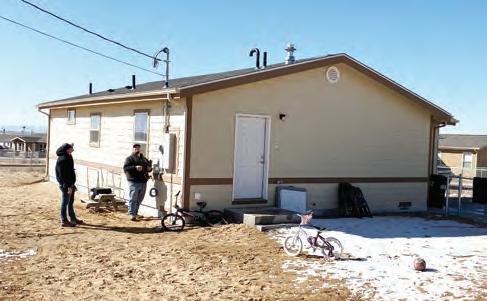
Initially, Sacred Wind leveraged the infrastructure it inherited, but it came with limitations. “We purchased the last mile facilities from Qwest Communications in 2006,” said Cooper. “The old copper plant was built in the 1950’s and strictly intended for voice. We came in and rebuilt it for DSL, but we found it was extremely expensive to expand
that copper out to more customers because of the terrain and how sparsely populated the area is. You’ll go three to ten miles before you’ll hit the next home.”
Over the past 15 years, the company has steadily upgraded its entire network. It first deployed fiber within its core network so it could effectively provision DSL services through its digital loop carrier cabinets closest to its customers with service to the 25/3 broadband standard or better, depending on the quality of the existing copper plant. Now it is in the process of putting in fiber-to-thehome and increasing the broadband speeds it can deliver to its customers using Adtran equipment, starting at 100 Mbps and scalable to XGS-PON as demand moves up.
“We’re the first ones to deploy fiber to the home on the Navaho Nation,” said Neo Nicolaou, Sacred Wind Communications General Manager. “Our first phase is working with the Navajo Housing Authority (NHA) to construct fiber to the homes in specific NHA locations and provide broadband speeds up to 1gig.” Using an RDOF award, Sacred Wind’s affiliate SW DinehNet will connect 623 homes on Navajo lands via fiber and provide broadband speeds up to one gig. Sacred Wind and its affiliates applied for ReConnect 3 funds to extend their fiber to the home coverage further into tribal lands, expanding upon the initial infrastructure.
Sacred Wind expects to add over 400 miles of fiber to its network this year. “We’re connecting homes using a number of funding mechanisms,” Cooper said. “We will build infrastructure with one program to put in a fiber then come back with a different set of funds and our own funding to turn up communities along the route.”
The FBA and NTTA are working together to create programs to educate, train and mentor tribal leaders on the development of fiber broadband networks. Other programs exist through federal grants and public/private partnerships that can be leveraged to ensure the networks needed are built to serve tribal communities. A partial list includes the American Indian Policy Institute, U.S. Department of the Interior Indian Affairs, NTIA’s Tribal Broadband Connectivity Program, and The National Digital Inclusion Alliance to name a few.
(continued from page 23)
parties, because when they used to place some fiber into a duct, for example, traditional compensation plans say that’s two units because contractors are paid on units. They like to charge for two units per install, but that needs to be negotiated up front regardless of the technology. We’re working really hard to educate the service providers on what plug-and-play can do for them and let them know that they’re going to have to renegotiate compensation with their contractors because with plugand-play, you can deploy and build homes at a faster rate since it takes out the splicing.”
But there are benefits with the contractor who can place and connect more homes faster, enabling them to quickly move onto the next project. “With fair negotiation, everyone wins,” Hill stated.
Using plug-and-play technology for turning up service enables service providers to centralize splicing to one location, with the technician splicing a lot of fiber at the same time, not having to set up and tear down cable to do a single splice at multiple points along the logical fiber path. Since the splicing technician no longer has to travel, installation times are significantly reduced.
Newer technologies rolling into fiber installation promise to further increase the efficiency and effectiveness of technicians. Diagnostic equipment, such as optical timedomain reflectometers (OTDRs), continues to improve, providing deeper tracing of fiber splices, said Hill. Splicing equipment is very sophisticated and is “almost dummy proof,” Hill remarked, while there will be products that come out with some ability to self-clean before splicing.

“The equipment is getting really good, but it’s still important to train the technician on what he’s looking at,” Hill said. “Sometimes the underlying algorithms of test equipment provides a trace interpretation, so if the technician doesn’t understand what a trace is meant to do, they won’t know if they have a false reading. We’ve had contractors using new software say that we put in bad fiber, but it’s because they didn’t know to interpret the trace.”

The Fiber Broadband Association (FBA) recently completed the pilot program for its OpTIC Optical Telecom Installation Certification training program. FBA is working with dozens of community colleges across the country to help expand the reach of this program designed to train a new wave of certified optical technicians as a mechanism to support the industry as it enters the next phase of fiber broadband rollouts. At Fiber Connect 2022, FBA is hosting its Train the Trainer program as part of this effort. More information on the FBA’s OpTIC training program can be found on the Fiber Broadband Association’s website: https://www.fiberbroadband.org/page/fba-optic-opticaltelecom-installation-certification

Contact Lucy Green at lgreen@fiberbroadband.org for sponsorship opportunities.
Please note editorial topics may be subject to change based on future events and market shifts.
September 2022
Materials due August 19, 2022
• Ten Communities Taking Fiber Further - Our mega-roundup
• Fiber Connect 2022 Wrap Up
• Proof of Concept – What We Learned in Nashville
• Beyond Broadband – Applications for Growth, including: IoT; SmartHome; SmartCity to SmartTownship; SmartGrid; Precision Agriculture; and Smart Construction
• Executive Insights | Federal/State Update| Innovation at Work
November 2022
Materials due October 19, 2022
• Fiber Under Forty - Identifying young, emerging leaders in the industry
• Progress report – Where are we with $65 billion?
• Broadband for Good including: Decreasing the digital divide; Telehealth/ Telemedicine; Public Safety
• Executive Insights | Federal/State Update| Community Profiles | Innovation at Work

Fiber Connect 2022
Conference & Expo
June 12–15, 2022
Gaylord Opryland Resort and Convention Center, Nashville, TN
www.fiberconnect2022.org
Regional Fiber Connect Workshops
August 23, 2022
Copper Mountain, CO
November 3, 2022
Columbus, OH
OpTIC™ Train the Trainer Sessions
June 12–15, 2022
Collocated with Fiber Connect 2022 in Nashville, TN
www.fiberconnect2022.org
Fiber Connect LATAM Events
Email latamchapter@fiberbroadband.org for more information.
July 11 –12, 2022
Intercontinental, San Jose, Costa Rica
November 8-9, 2022
Bogota, Colombia

